#actually for some reason its on the japanese disney+ but not american
Text
instead of supporting disney's latest cash grab can i suggest watching The 7D instead? it's a spinoff series that came out 9 years ago that disney cancelled prematurely during season 2. it's hilarious and well animated and some of the writers worked on Animaniacs so that's how you KNOW its good.
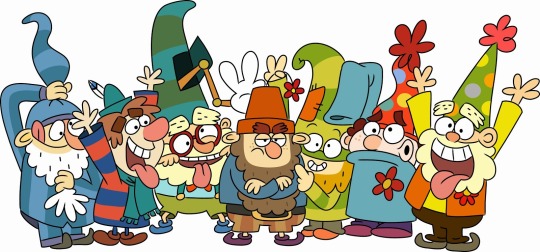
#u guys are gonna have to sit back for this cuz the 7d was my first tumblr fandom#snow white and the seven dwarfs#the 7d#when will the live action reboots stop bro come on#its actually amazing how disney finds ways to screw the 7d over tbh#like leaving them out of the anniversary tribute for starters. dont even get me started#thankful it exists online in good quality so we dont have to depend on disney+ ever deciding to acknowledge the series#actually for some reason its on the japanese disney+ but not american
76 notes
·
View notes
Text
@rustyrick2022 replied to your post “I’ve noticed that some of the dub writers have...”:
Yeah, it's a shame if you ask me, but the dub could have ultimately turned out a lot worse, and despite some elements just being eye-rolling for me as an adult, I still think it's servicable.
Pretty much. I do think it’s a serious problem that the Digimon fanbase will just outright dismiss the idea the dub changes matter for anything just because it was “fair for its day” -- just because it was comparatively closer to the original next to other dubs of its time doesn’t mean those changes weren’t significant at all -- but at the same time, the fact it wasn’t nearly as aggressive as other contemporary dubs is actually true.
Not even for the reasons most people cite. The usual go-to standbys for claiming “the Digimon dub didn’t change that much” are:
"They gave the kids 'nicknames' instead of changing their names fully”: This only applies to Adventure, and in practice the “nicknames” were pretty much exclusively used in the series and merch, with their “full names” never to be seen past the first episode (and when “Izzy”, a nickname based on a character’s surname, is used by the kid’s own parents, it’s clear that “retained names” is really not the case in practice at all). You’d have a better case talking about the high percentage of retained names in Tamers and Frontier (but those were around the time of the Disney switch, so...). In addition, while “name changes” are an easy low hanging fruit when it comes to talking about localization, they actually say very little about how much the series changed on the whole. Data Squad turned “Noguchi Ikuto” into “Keenan Crier”, and yet is probably one of the closer dubs to the original Japanese source material.
"They left the setting in Japan”: ...but they also took out 95% of the cultural context that came with it, and basically the only reason they even were willing to admit the Japanese setting was because the Odaiba arc in Adventure involving so many real-life locations pushed them into a corner. Before then, they turned Hikarigaoka into Highton View Terrace, and they tried very hard to avoid the word “Odaiba” even after that.
However, it is true that if you looked at the other dubs from the infamous 4Kids and such at the time, you’d be looking at things like entirely cut or shifted episodes, cut arcs, heavy changes to the plot itself, and so on and so forth. As far as Digimon’s American English early dubbing went:
No episodes were cut (not even one!). The majority of footage cuts/edits are relegated to little things like impact frames, cigarettes and alcohol, toilet humor, and other fairly minor things. Contrary to popular opinion, I don’t actually think Citramon is that big of a deal. (The part where they danced around Kurata planting a bomb on Relena might be more important, but even then that’s nowhere near cutting a full episode.)
With one exception, all character deaths were treated as deaths and not covered up, and the impact said deaths had on the characters around them was thus treated accordingly. (I'm absolutely not in the camp who calls for bloodshed for the sake of it, but I think we can agree that there are a lot of plot points revolving around characters’ deaths and grief over them that would be very seriously damaged if said deaths were cut.)
Even at its most extreme moments of inserting jokes during mental breakdowns, it still let the important drama scenes stand to some degree. Too many things weren’t even willing to do that.
As much as I think the Digimon fanbase downplays the amount of characterization changes that happened in dubbing way too much, it’s also true that you’d see this much and more in other contemporary series -- it’s just that Seki-produced Digimon being so incredibly character-centric, along with Adventure and 02 having ridiculously single-line-dependent writing styles, made even small changes have more of an impact than probably anyone expected. (To be honest, I’m willing to give the dub writing team benefit of the doubt that they didn’t think the changes they were making would be enough to bite them in the rear later as much as they did. You can actually see an attempt to back down on the changes in the latter half of 02, presumably because they realized how bad things were going to get if they didn’t stop going off the rails with Daisuke.) Also, I have a hot take in that the American English dub take on Ken is arguably more accurate to his original character than the way a lot of fans talk about him in Japanese...
Even if they were often insensitive about it, the dub writers for Digimon did actually like working on it and are still happy to talk about it, which is significant because you would not believe how many dub writers back then seriously despised the very material they were working on and wrote it with the attitude of it being as shallow as they saw it as. It’s a low bar, but at least our Digimon dub writers seem to have respected the series on some level.
The Movie is a total mishmash, but it’s hardly the only mishmash dub product in existence (Robotech, anyone?), and it’s also not like anime theatrical movies would often make it to localization at all -- especially when we were lucky enough to still get some of the other movies too!
The voice acting is actually really good! I wondered if this was maybe just my bias, but no, Digimon really was blessed with a good cast and good voice direction compared to a lot of dubs that are painful to watch even with good scripts.
All of these really feel like low bars/the bare minimum in retrospect, and I don’t think they should be above criticism for these. But that really was what dubs were like back then! I’m not going to hold back in any criticisms or complaints I have about it, and I’m still going to call out the fandom myth of it being a dub that “didn’t change much”, but there’s only so much I can get worked up over something from 20 years ago that was in line with an entire ongoing industry problem. It could have been worse. It could have been a dub that completely stepped all over the characters and really did make it into a soulless toy advertisement, but it still did most of its job of touching kids’ hearts and conveying the important messages and give us something to talk about all these years later. And I mean, I took 02′s message of not getting too hung up on the past we can’t change instead of prioritizing what to do going forward very much to heart, so that’s how I feel about it now.
78 notes
·
View notes
Text
Mitski - The Land Is Inhospitable And So Are We
Seventh album from the New York-based Japanese/American synth-pop singer songwriter produced by Patrick Hyland
11/13

Back in September of 2019, Mitski had finally had enough. She left fans stunned and concerned when she announced that her Central Park performance, scheduled on the 9th of that month, would be her “last show indefinitely.” People took to online forums, trying desperately to decipher Mitski’s cryptic use of ‘indefinitely’, and speculating about the potential causes of this bemusing decision, and more importantly, the potential effects.
Thankfully, Mitski would clarify soon after, to a collective sigh of relief, that her departure from the music scene would not be a permanent one. She initially reasoned that her five years of non-stop touring had left her exhausted and entirely untethered from any semblance of a real home. She would later clarify in a tweet that her efforts to thrive in the music industry had made her both disillusioned by and numbed to the experience. “I sense that if I don’t step away soon, my self-worth/identity will start depending on staying in the game, in the constant churn,” she said.
That Mitski had become numb bears repeating. She herself pointed out that by becoming devoid of emotion, she was missing the key ingredient of all her music: her feelings. And so, despite all of the recent accolades she’d received for her stunning and dripping-with-feeling fifth album, Be the Cowboy, and her attendant rise to the fame and ever-growing fanbase, Mitski would make good on her words and dip into a self-imposed dormancy. For her, the accolades were a curse. Her ascendency to the throne only added pressure for her to maintain her successes, and this quickly cast a shadow of self-doubt over every project she attempted to make.
Fans would just have to wait.
At some point during her hiatus, Mitski realized that she was still contractually bound to release another album for her label, Dead Oceans. And, long story short, she would finally re-emerge in late 2021, three years the wiser, with the shocking announcement of a new full-length, Laurel Hell. The album title itself referred to the large thickets of laurel bushes spread across the Southern Appalachians, where people have become stuck in their massive tangles and never made it out alive. More tellingingly, however, is that ‘laurel’ also means recognition of an award or achievement, and, given its pairing with ‘hell’, it provided a clear-cut indicator of her mindset at that point. The music reflected this idea as well, and while it was warmly received—the album even spent a week atop the Billboard charts—you could tell that it was the product of a different, more nuanced Mitski who was at least trying to care less about the reception it got.
And this brings us to Mitski’s new release, the compellingly titled, The Land is Inhospitable and So Are We. True to the name, the album is dark and brooding; a rumination on lonely love and the havoc and agony it can generate. Mitski faces the love in her life head on, highlighting both its redemptive and destructive qualities. To augment the desolate longing of her poetic, otherworldly laments, Mitski has fashioned a striking sonic evolution from the edgy synth-pop that’s preceded it. This is Mitski as a forlorn country troubadour, conjuring the analog soundscapes of 70-era Emmylou Harris and Linda Ronstadt, as well as the later releases of Nancy Sinatra and Lee Hazlewood. A more recent spiritual touchstone is the moody, dreamy Neko Case classic Blacklisted.
Mitski spoke recently in an interview with BBC Radio 1, and she indicated that she worked on the album with orchestrator Drew Erickson, who conducted its arrangements by gathering a team of top guns (some of whom have played on actual Disney soundtracks) in Los Angeles and laid down the orchestral parts there. Mitski set out all of the choir parts herself, with a total of 17 voices utilized; 12 in Los Angeles and five in Nashville. In the latter city she stayed and recorded her parts with a proper ‘Nashville’ band and studio. The confluence between the high and lonesome and the cinematic creates a brilliant, beautiful, and heady aesthetic, and Mitski stands in front of it all, displaying a fervor that (re)establishes her as the preeminent singer-songwriter of her generation.
The Land is Inhospitable and So Are begins with “Bug Like an Angel”, which is also the first single released from the record. It’s a bold and deeply moving dirge, which begins with her plaintive acoustic strums and reverbed vocals almost recalling Guyville-era Liz Phair at her softest. Mitski coos, “There’s a bug like an angel stuck to the bottom of my glass / with a little bit left / When I was older I learned I’m a drinker / sometimes a drink feels like family.” This is followed immediately by an explosive and surprising choir echoing, “Faaamilyyyyyy!” which then recedes, allowing Mitski to ask, “Did you go and make promises you can’t keep?” The choir then rejoins her as she alluded to those broken promises: “They break you right back / Break you right back.” And this, if you’re wired a certain way, will send literal shivers down your spine. Mitski’s performance here is both daring and confident, affecting and devastating, and she invokes a graceful empathy in her haunting delivery.
Second single “Heaven” immediately establishes the ‘Nashville’ in her Nashville band, as a slow drum shuffle is met with soft acoustic guitar strums and the lonesome wail of steel guitar. During the BBC 1 interview, Mitski described “Heaven” as a “classically romantic song… seeking to cherish the small amount of time you have with the one you love.” The song depicts Heaven as, ‘Well, let’s leave the world outside of our room for now, and enjoy this beautiful love we have’.
“Heaven”‘s lyrics are paired perfectly with song’s countrified lilt, which is steadily encroached upon by surging strings that build to majestic proportions by the song’s dramatic finale. The orchestration is never pandering or gratuitous, and is there to manifest a certain emotional gravitas before swiftly receding, never a second too late. It’s just as it was with her considered inclusion of the choir in “Bug Like an Angel”; in both cases, her relative restraint ensures that these crescendos never outstay their welcome, and after multiple listens, the emotional impact does not diminish. The shivers still come.
“Star” places the orchestration front and center as strings swirl and multiply, steadily building to a dazzling frenzy. This is Mitski reaching for the firmament. For her, love is like a star in that, despite it no longer being there, still shines on when you look up at it. “I’ll keep a leftover light burning / so you can keep looking up,” she emotes. “Isn’t that worth holding on?” Mitski’s dense metaphorical prowess is on full display here, and one of the many ways she likens love to a greater outside force throughout the album’s slim 32 minutes.
Some might recognize the influence of Mazzy Star on mid-album track, “The Deal”. The band shuffles along on a “Fade Into You” sway, while Mitski sings, “There’s a deal you can make on a midnight walk alone / Look around, listen close, hear it call from above / It will ask you what you’d give and what you’d take for it in return.” She is ready to give away her soul, “just to give it,” and will face the consequences. As the urgency in Mitski’s voice continues to rise, a maelstrom of drums comes crashing in, leading to a menacing climax as Mitski repeats, “I’ve made a deal.”
On “The Frost” a warbling church organ and mandolin are added to the mix, and the song advances, sans the orchestral accoutrements, as a gorgeous meditation on loneliness. Mitski observes, “The frost, it looks like dust settles in the world / after everyone’s long been gone / But me, I was hiding or forgotten / the only one left, now the world is mine alone.”
The stunning “I’m Your Man” unfolds quietly, just Mitski and her guitar. “One day you’ll figure me out / I’ll meet judgment by the hounds / People always gave me love / others were never to blame, after all / You believed me like a God / I betray you like a man.” As the song comes to a close, she is surrounded by barking dogs, croaking peepers, and a multi-part choir singing into the night.
With The Land is Inhospitable and So Are We, Mitski seems to have regained her footing and created a laser-focused album, filled with sadness and hope and defeat, all with the brilliant backdrop of organic Americana and bombastic orchestral passages. The album’s brevity only adds to the allure, as it is stripped of any excess, and devoid of a single misstep. It is a distinct departure, but ultimately unsurprising in its flawless execution. As long as Mitski is at the helm, fully rejuvenated from her hibernation, we can only expect the best from her from here on out.
youtube
1 note
·
View note
Text
'Oppenheimer is one of the most hotly discussed film releases of the year, especially when compared to the release of Barbie, with the two films standing in stark contrast to one another as they both head for box office domination. But there is one country where Oppenheimer may fall short, and there is a reason tangled in history and pain for that.
Currently, Japan has no release date for Christopher Nolan’s film about the creation of the atomic bomb. Japan is the only country in which atomic bombs have been used as a part of warfare, with two dropped in 1945, one on Hiroshima on Aug. 6 and the next a few days later on Nagasaki on Aug. 9. The result was over 200,000 civilians dead and thousands more displaced and suffering from the long-term effects of radiation poisoning.
These two devastating bombs dealt the last blow to end WWII, but their destruction was catastrophic, bringing Japan to its knees and forcing an unconditional surrender. You can see why a movie about the creation of such weapons of mass destruction has a different impact on this country. The absence of a release date for the film in Japanese theaters is attributed to various reasons, including their own history with the subject matter and the workings of the movie industry here.
Why does it not have a release date in Japan?
Western movies, particularly the big blockbuster crowd pleasers like Marvel films or Disney animations, frequently dominate the lineup in Japanese theaters, while foreign films often face challenges in securing screenings here. It is likely that, even with its subject matter, Oppenheimer will gain a release; the question is more about when.
As reported in Variety, Universal stated that “plans have not been finalized in all markets,” which could mean that they are simply still organizing when to release the film. They may feel that the U.S. release date is too close to the anniversary of those devastating days and may be holding off to wait until some time has passed before releasing here out of respect. As of last week, Toho-Towa, the distributor responsible for handling most Hollywood films in the country, had not yet screened the film.
Many Western films get slightly later release dates in Japan as it is, with Barbie not premiering until August 11 a full three weeks after its release in the States, so this could simply be the case as well. Hollywood has some influence in when their films are released here, but at the end of the day, Japan has the final say, as they have their own structure for releasing films, and it can sometimes be months behind release dates in their domestic country with release dates also taking some time to be announced.
Do Japanese theatergoers turn up for WWII movies?
There is another duality at play here as well. Nolan films do well in Japan, with Tenet and Dunkirk earning $25 million and $14.8 million in the country, respectively, but Western films surrounding the topic of the bombings don’t tend to bring out the crowds.
Hugh Jackman’s The Wolverine, set in Japan and featured a short sequence that showed the bombing, fell a little flat here with only $7.9 million grossed. The Clint Eastwood war film Letters from Iwo Jima, a Japanese language film with a Japanese cast and told from the Japanese perspective, did much better than the film Flags of Our Fathers, which told the same story from the American stance. So even if Oppenheimer is released here, the box-office takings may not be great, especially since it has also been rated R.
Of course, this makes sense. Japanese audiences will want to watch a film in their own language told from their own people’s perspective, so given that Oppenheimer is from the American view, they may not be as interested. That being said, reportedly, Pearl Harbor actually did quite well in the Japanese market, with Japanese critics being kinder to it than domestic critics.
Nolan believes that the story is an important one, though, saying at CinemaCon, “Like it or not, J. Robert Oppenheimer is the most important person who ever lived. He made the world that we live in for better or for worse. His story has to be seen to be believed.”
You can watch Oppenheimer in theatres in the States from July 21. However, for those like myself living here in Japan, the release date, if there even is one, is still unknown.'
#Oppenheimer#Christopher Nolan#Barbie#Tenet#Dunkirk#The Wolverine#Hugh Jackman#Clint Eastwood#Letters From Iwo Jima#Flags of Our Fathers#Pearl Harbor
0 notes
Text
Rhapsody: A Musical Adventure makes me smile, and that’s all it needs to do
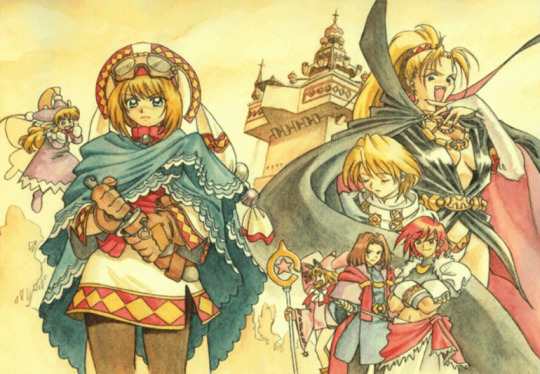
Amid the games offered in the Nis America’s rerelease series “Prinny Presents NIS Classics”, Rhapsody: A Musical Adventure doesn’t fit as well as the others featured. While a good amount of them offer complex combat and a huge amount of potential playtime, Rhapsody is rather short and… probably one of the easiest SRPGs ever made.
The only way you could guess why it got chosen to be a part of these rereleases is the fact that it is one of the first two tactical RPGs developed by Nippon Ichi Software before they hit it big with Disgaea, which changed the company’s destiny forever. This makes a lot of sense knowing that the game that accompanies it in its PC and Switch rerelease is La Pucelle, which is the only other SRPG title they made before the first Disgaea. Just by taking a glance, you can already see a big difference in how they chose to approach both games’ remaster. While La Pucelle received many quality of life changes, Rhapsody went relatively unchanged (besides now offering a beautiful CRT mode).
The reason for this is that the original 1998 Atlus localization for Rhapsody was already uncommonly complete for the time. It had options for both Japanese and English voice acting, extra unlockable illustrations, and the game was already easy enough that it didn’t warrant any balance changes for the west. Unfortunately, it did not sell well enough for its two sequels to also be localized, which is a shame because both seem incredible.
Note: Even though there are no currently available in-game translations for Rhapsody’s sequels, you can find fully translated scripts for Little Princess: Marl Ōkoku no Ningyō Hime 2 and Tenshi no Present: Marl Ōkoku Monogatari here and here, respectively.
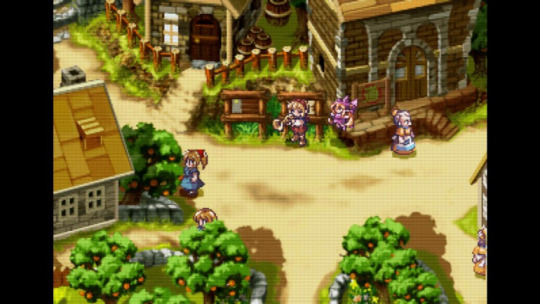
Even the game’s songs were completely rerecorded with English voices (though they are the only parts with any amount of voiceover at all). There lies the most intriguing part of Rhapsody. It’s a whole damn musical. Like, there are six unique songs coupled with some special versions of the main theme. Every song is sung in a perfectly (and sometimes beautifully) acceptable manner by the American cast. I was expecting the next song to arrive at every step I took while playing. Fortunately, the best songs here are sung by Cornet, and there are a lot of them because, well, she’s the protagonist and all.
It’s really impressive how unique Rhapsody ends up being because of its stylistic choices because deep down, it’s a pretty by-the-numbers JRPG. Enough so that it feels weird that they bothered making this a tactics game at all considering how little it matters for the game aside from making battles last longer since you have to position your party members on range to hit an enemy before attacking. On a normal RPG, it would take one turn to hit your opponent. Here, most party members take two to get their first hit in.
The easygoing difficulty on offer by Rhapsody is enough to get hardcore fans of the genre to completely ignore its existence, which makes sense if you’re only on the lookout for a challenge and nothing more. But I’d argue that Rhapsody is much more interesting when seen through other lenses.
For starters, it works perfectly as a potential first game for people who have never touched a game in their lives. Even some simple 3D titles considered to be good entry points by game fans end up being a headache for beginners, but Rhapsody here speaks for itself. If you ignore some repetitive dungeon layouts and one or two innocuous dialogues you need to trigger to advance the story, none of the mechanics here would seem confusing for a complete newbie.

This is understandable because the actual target demographic for this game is kids, even though it can handle serious topics in some story beats. Rhapsody is structured in a similar manner to a Disney Princess movie (only with the roles reversed), which is a big compliment coming from someone like me, who absolutely adores Cinderella and the likes of it. Cornet is a daydreaming girl that can talk to and understand any puppet/doll. Now that I mentioned it, she can even transform them into party members by playing her favorite melody on her cornet. They’re not only important to the narrative, but also to the combat, where they work kinda like they do in Dragon Quest V.
However, the only puppet that can’t fight is Kururu, Cornet’s favorite that has been with her since her mom was murdered during a mysterious war that was going on at the time. Kururu is present throughout the whole game and acts as a mentor figure that forces Cornet to make difficult decisions (and sometimes makes some for her, which often backfires). The first song that features any vocals (excluding the intro one) only gets to play because of Kururu, when she asks Cornet to play “her favorite song”. Now the same song she loves playing on her cornet gets to be interpreted vocally for the first time in the game. It’s called Let’s Go On and it regularly gets different verses when it gets reprised in later sections of the plot, from which it adapts its tone to fit.
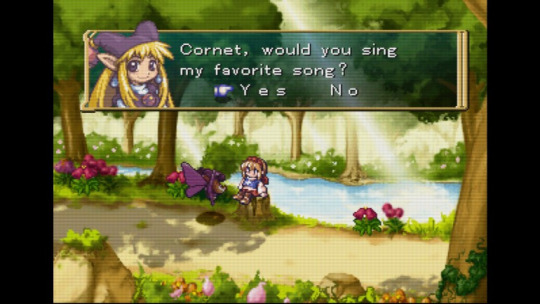
The cutesy animations that Cornet and the other characters make when they sing their tracks are immensely adorable and help them be more memorable than they would otherwise. They’re essential little touches that serve to not make the songs seem like they completely halt the game’s narrative. Oh, besides, they also advance both the story and the characters’ individual arcs!
This makes me a little bummed out since there are one or two songs that are not only way too short, but also don’t help out that much in developing the story, particularly the ones placed in the middle of the adventure. Nevertheless, I’d say that the way they incorporated the musical elements into the rest of the game was made with care, and forms an irreplaceable piece of the emotional impact Rhapsody’s story seeks to usher in.
Cornet loves singing as much as she dreams about being rescued by the beautiful Prince Ferdinand, who she’s completely obsessed with. Her dream kinda comes true when he randomly shows up to rescue her from a dragon conjured by Myao, an easily irritable witch that controls the population of anthropomorphic cats that live in the Wonder Woods. Unfortunately, Cornet is just as human as any of us and completely freezes when confronted by her crush. While Ferdinand tries to talk to the anxiety-ridden static girl, she can’t as much as move a single pixel.
In the end, she ends up not even being able to share her first name with the prince, which worries her because how lucky would she have to be to find Ferdinand again? He lives in a castle inside the big city of Mothergreen while Cornet lives in the rural Orange Village. He’s royalty, and she’s a plebeian. So of course she goes out to find him anyway.
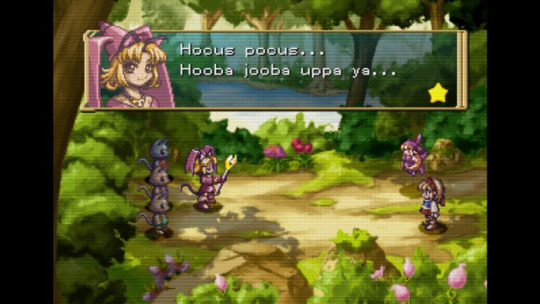
Let’s skip a tiny bit of the important character stuff established early into the first hours of the adventure because I really want you to actually play Rhapsody instead of only reading my article about it. Amid an annual (and official!) contest in which girls take part to gather the prince’s attention, Cornet manages to reconnect, even if negatively, with her spoiled and fashionable childhood friend Etoile and ends up tying with her at the top spot of the contest.
The only problem is that Myao remembered how embarrassed Ferdinand made her feel the day he defeated her, so she ran a dragon through the castle walls and, accompanied by her friends Gao and Crowdia, let her mentor Marjorly steal the prince for herself. Being as clumsy as she is, Marjorly ends up transforming the poor dude into a statue by accident instead of using the love spell she intended to.
That’s when the game starts to open up. Cornet gains a new stylish outfit, the famous elemental stones are introduced for you to hunt down, etc. You know, the classic structure of a run-of-the-mill JRPG of that time. I’m not going to lie here, some narrative concepts Rhapsody tries to explore are not that interesting, but… I’d be a complete liar if I omitted how much the characters and their individual arcs are used to transform what could be a boring story into an actually engaging one.
First off, the dynamic between Cornet and Etoile represents a good example of this exact thing. They’re always fighting and the person who most often starts throwing insults around is Etoile. But you can see in the way in which they interact (and confirm with later story events) that in reality, they are just inseparable friends. Etoile is also searching for Ferdinand, but instead of taking Cornet’s puppet-based heroic approach, she hires bodyguards to protect her with guns. A bunch of them. She even gets some herself. Yeah, this seemingly medieval RPG introduces firearms out of the blue. How cool is that?

Even as rivals, they can’t help but give each other a hand to move on. This is made clear right at the beginning when Etoile and Cornet start to fight to see who says sorry first to the close person which they emotionally hurt during the contest’s events, and it gets even deeper as their relationship develops while you’re on the search for the elemental stones.
Each of the stones is located in a remote place that has its own history attached to the artifact. This part of the game focuses on telling five different tales independent from the main story arc with a surprisingly high variety in tone and unfortunately, quality as well. Of course, it’d be weird to expect complete consistency between the five stories, but some of them don’t even look like they came from this game because of how tonally off they are.
The search for the Waterstone on the pirate boat is a good example of this. You meet pirates that have been victims of a shipwreck that killed a big chunk of the crew in the past. The victims’ dad and best friend are still on the high ranks of the crew, and they both blame themselves for the dude’s death. This part doesn’t offer a traditional dungeon but instead the boat you can explore, which is pretty tiny. Together, the three pirates involved in this plot have about 30 lines of dialogue, and that’s it.
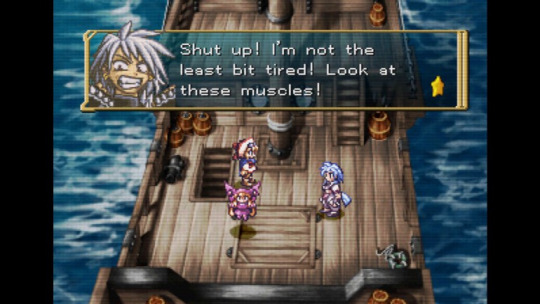
This doesn’t go for all of the elemental stone quests though. Some of them end up in tragedy, and almost all of them require Cornet to make a morally questionable sacrifice in order to get a stone. I’m not going to go into much detail so I don’t spoil anything, but what I’ll say is that the game presents very abrupt and heavy scenarios on occasion, which is pretty cool. These end up making up the most interesting pieces of the middle section of Rhapsody, which needs to have a bigger emotional heft to function properly because of its problematic dungeons.
Funnily enough, I haven’t been that satisfied with the dungeons in most recent RPGs I’ve played, even though I have a bigger tolerance for grind and repetition than most people. Games like Crystar and Cruel King and the Great Hero were way too repetitive for my thumbs to even enjoy playing them, and unfortunately, I can say some of the same things for Rhapsody’s dungeons. The common link between these games’ dungeon crawling is that they only exist in order to space out combat encounters instead of requiring thorough exploration.
In Rhapsody, there are two types of dungeons: caves and towers. If you’ve seen either one of them, you’ve seen them all, because the only difference you can spot is an occasional color palette swap. They’re just collections of square rooms with paths — Zelda style — but with a whole bunch of nothing inside. They only lead to new floors, maybe some items and extra collectibles, and eventually a boss. Navigating the dungeons isn’t a difficult task since the combat never drains your resources, but I still lost a couple (maybe more) hours just trying to get my bearings because of how repetitive they feel. Don’t feel bad for looking up a dungeon map online if you’re getting bored.
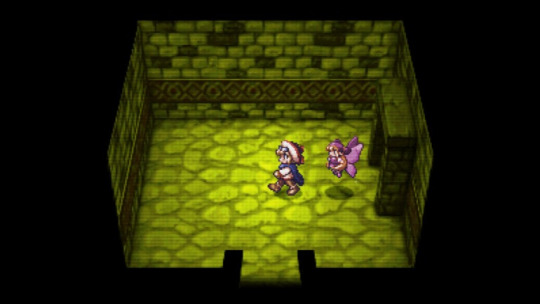
The dungeons do take a considerable amount of the overall playtime, but that sure wasn’t enough to ruin my experience, not even close. What matters here is that outside of them and during the dialogue and beautifully drawn areas, things work out much more smoothly. Cornet manages to create a genuinely deep connection with the rest of the main cast because she’s constantly humanized. Her decisions are what make her strong and Kururu, Etoile and her grandpa are all there to reinforce exactly this.
It would be cool if the puppets spoke a little more during the story, but at least they gain an interesting bit of focus on the village side quests (and the worldbuilding). They’re kinda hard to find for yourself, so I recommend a guide if you wanna play ’em all. Besides that, they let you in on more solid context to what is one of the biggest emotional pillars present in Rhapsody’s world, which I’ll touch on now without getting into spoilers.
Rhapsody has a few plot twists just like any ambitious RPG. One of them made me tear up. This is the first time this happened to me in a game where the pace is controlled by the player. In a cinematic title like, say, Life is Strange, it’s easy to get emotional in a scene cautiously acted and paced to gather this response. I know this because it happened to me a few times (lol). Now, in a JRPG with no voices (at least when no one’s singing) with the dialogue speed controlled completely by the player, this caught me completely off guard.
What happens here is a beautiful role subversion that ends up recontextualizing the whole game and that made me realize how important it was for Cornet’s arc as a whole after reevaluating the couple hundred screenshots I took while playing. Since I don’t wanna spoil anything, I’ll leave it at that.
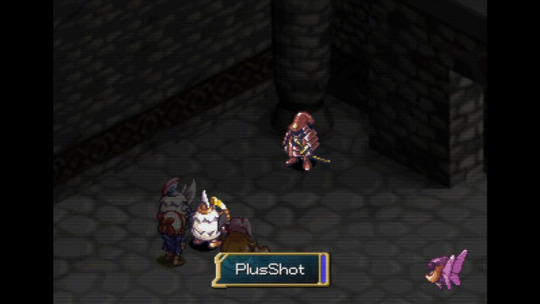
The last thing I wanna say (exactly after saying I’ll leave it at that, no less) is that this twist ties the songs and the ambiance together both thematically and practically, so much so that it ends up stealing a bit of the climax’s shine. It was the perfect last screw to drill in my head how special Rhapsody really is.
Besides its narrative, the game also shows its personality in many other areas, and constantly. For starters, it pays out really well to poke around random objects trying to find any extra dialogue or a hidden potion or to, even more so than in other JRPGS.
Potions and extra items don’t matter in the grand scheme of things considering how easy the game is, but sometimes you get some cute illustrations or even a little jingle that sings “Nippon Ichi Software”. Yes, I checked: it said “Atlus USA” in the original version. The change may have happened in the DS version (though I’m not sure) and then reused in this current port.
It’s great to have these occasional jokes and extra dialogue that you get while just interacting with samey-looking things in different-looking places. Usually, Cornet will comment on how strange it is to see a repeated asset or even infer some difference she can see even though the graphics don't let us see it as well. Some people have a bunch of problems with how Atlus localized their titles at the time and I do agree with some of those arguments, but I can’t see how this would have negatively impacted Rhapsody in specific. Honestly, the dialogue here sounds more current than many other drab modern localizations made by other companies.

Besides that, the visuals themselves are also refreshing. The character portraits show a lot of personality, and there are so many of them that I swear some of them are just used once or twice throughout the whole game. Lastly, we have the surprisingly good fashion sense present, which is mainly represented by Cornet, who completely changes her fit as soon as she leaves to search for her prince. Remember, those are whole animations that had to be reworked for this to be implemented, and that’s something only a game made with love can achieve.
Rhapsody: A Musical Adventure was an unforgettable experience, even though the idea didn’t reach its full potential in this title. I really hope NISA is interested in localizing the sequences, but I know that’s not an easy task. Just for some perspective, one of the fan-translated scripts I linked earlier, the one for Tenshi no Present: Marl Oukoku Monogatari, has 42.000 words in total, and at least up until the sections I read there weren’t optional NPC dialogues in there… Translating and implementing the translation into the game isn’t an easy task, but I still think it’ll be worth it if this Rhapsody rerelease does well.
In order to make a special JRPG, a perfect combat system or impeccable dungeons are rarely needed. It’s honestly easier to achieve this using the genre’s biggest strengths, which are its scale and ability to use unique storytelling methods to enhance a narrative. Rhapsody takes advantage of both while adding its own secret sauce, which is the musicals accompanied by big doses of care. In fact, I think tender is a good word for summing up the experience.
May the world turn into a more tender place, and may Rhapsody provide the tenderness you need then.
bye!

1 note
·
View note
Text
X-Men Abridged: 1979
The X-Men, those globe-trotting mutants that have sworn to protect a world that hates and fears them, are a cultural juggernaut with a long, tangled history. Want to unravel this tapestry? Then read the Abridged X-Men!
(X-Men 117 - 128, X-Man Annual 3) - by Chris Claremont and John Byrne, Terry Austin, George Perez
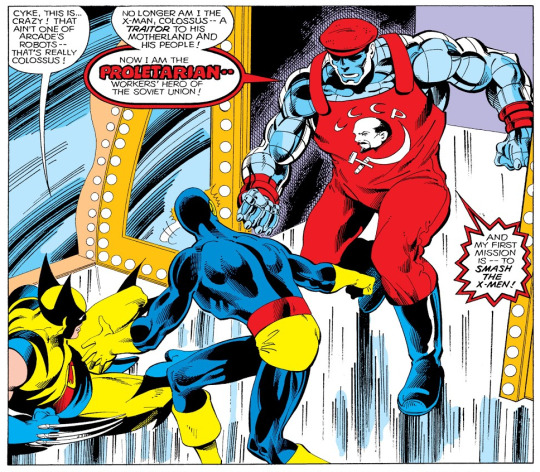
See Jean? Dark Phoenix is nothing: this is how you turn evil properly. (X-Men 123)
So, these things have been getting longer. Whoops.
Last year, plotlines tended to bleed over in one another, but this year is a lot more arc-based, jumping from location to location. This is basically X-Men: World Tour. After hitting Antarctica and the Savage Land, our team of merry mutants visits Japan, Canada, Egypt, Scotland and even a theme park! (And really, both Murder World and Disney Land are run by capitalist scumbags who pretend to be in it for the art, the only difference being that Arcade purposefully murders his guests.)
But, before we check in with the X-Men, we return to the Institute. See, there’s a mutual misunderstanding that wouldn’t be out of place in a Shakespearian tragedy: Jean and Charles think Beast and Jean were the only survivors of their fight with Magneto in Antarctica, while the rest of the X-Men believe they were the only survivors and Jean and Beast perished. Since the X-Men have been trapped in the Savage Land, nobody has been able to clear up the confusion.
With their grief driving a wedge between her and Charles, Jean leaves the mansion to deal with her feelings on her own. (She’ll end up on Muir Isle.)
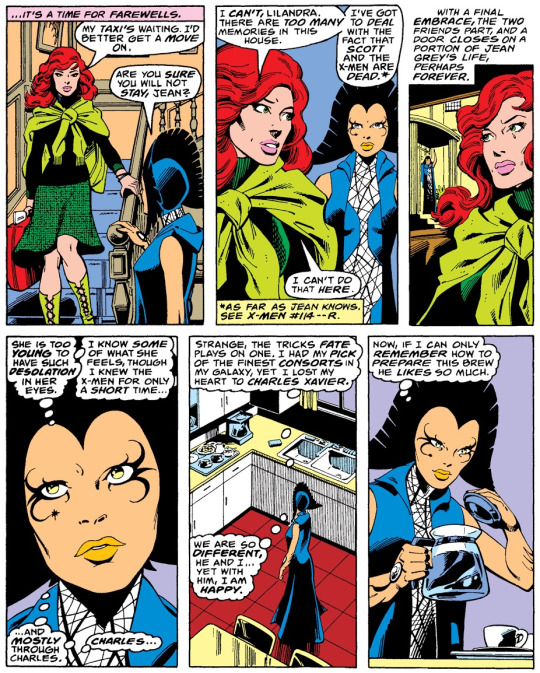
This is adorable! And, if the whole "Empress of the known Universe "-thing blows up in her face, she can always become a barista at Starbucks. (X-Men 117)
Lilandra successfully persuades Xavier to leave Earth as her consort, now that there is nothing left for him. Xavier agrees, but not before having a flashback to the time he met another telepath named Amahl Farouk in Egypt. (The Shadow King isn’t relevant just yet, but he’ll become an important villain later on.)
The X-Men, meanwhile, cross a treacherous ocean on a raft and are picked up by a Japanese vessel. The Japanese do not allow them to call anyone, for some reason. Sure. When they finally dock in Japan - six weeks later - some arms dealer named Magnum Moses has put Agarishima is on fire. Like, literally an inferno of such big proportions that even Storm can’t do much.
What follows is an uninspired, slipshod adventure. For some reason, Misty Knight and Colleen Wing are there too, because the president needed American detectives to investigate Magnum Moses (?) and for some reason, Misty doesn’t know Jean thinks Scott is dead, nor does she mention she just saw Jean to Scott. AUGH. It will take almost a year for Scott to figure out Jean isn’t dead and it becomes increasingly more contrived. I get that Claremont needed to isolate Jean to make her susceptible to, er, a certain someone’s machinations, but holy fuck do I have to suspend my disbelief for all of this bullshit.
The only good things about this little arc are:
Sunfire is still a dick.
Wolverine meets Mariko Yashida, a Japanese girl who actually reciprocates his feelings, as opposed to Jean. I’ve mostly been ignoring his budding feelings for Jean, because I stopped finding love triangles interesting since I was 16 and watched The OC, so I can only applaud this development. Mariko brings out Wolverine’s soft side and it’s very adorable. Later on, she moves to NYC for some reason and they start dating.

There is something sweetly disarming about calling Wolverine ‘beautiful’. (X-Men 120)
Anyway, Magnum is holding Japan hostage: either they give him what he wants - I think that might be money, sorry, wasn't paying attention - or he sinks Japan by activating the fault lines and you guys, I am sooo bored. Unsurprisingly, the X-Men stop him and for once, it’s Banshee who gets to play the most important part.

It’s a good thing I was terrible at science, otherwise I might have to point out that earthquakes and sonic waves don’t work that way! I simply get to be entertained by little rascal Colossus, plugging his ears like a toddler, and Sunfire’s gritty determination to not be impressed by some silly screaming Irishman. (X-Men 119)
Banshee pays a steep price for the victory, however: his vocal chords end up damaged, leaving him effectively powerless for the remainder of the year.
Oh, and here’s interesting fact about the above spread: you may or may not know that Chris Claremont and John Byrne were notoriously terrible at working together; this issue became a particular sore point between the creators. See, Byrne wanted to run the above panel without the sound of ‘Kra-Koom’, believing the art was strong enough to convey the destruction. He was livid when the finished product ended up containing a sound effect after all. I get your frustration, man, but if you want a writer who knows how to say less with more, you should maybe not work with Claremont?
(One of the reasons Claremont liked being so verbose and descriptive in his scripts was because otherwise, the artist would fill in the blanks using his own imagination. It’s no wonder these two found it hard to work together.)
On the flight to the US of A, Colleen Wing hits on Cyclops. It has to be the jawline, right? It can’t be the personality. All of a sudden, a snow storm causes their plane to be diverted to Calgary. The cause of this delay is Alpha Flight, who want their Wolverine back!

When even the narration is all “and they think they’re equal to any team of superheroes”, you know you’re a bunch of C-listers. Ugh. (X-Men 121)
Vindicator, previously known as Captain Alpha. He changed his name after accidentally shooting Moira that one time, which is exactly the kind of hollow gesture this dude would make. Ugh. If you think his new-found remorse won’t let him threaten an airplane chock full of innocent passengers, you would be wrong.
Shaman, doctor by day, magic user by night. Him and his magical little pouch are to blame for the snow storm.
Sasquatch, Canada’s answer to the Hulk. (Hilariously, the theory on why he turns furry instead of green is because he’s closer to the Aurora Borealis and this somehow messes with the radiation?)
Snowbird, a young Arctic goddess. Precious. To be cherished. Barely there for this adventure, sadly.
Northstar, an arrogant, hot-headed speedster, the twin brother of
Aurora, a lover, not a fighter. Together, they have light powers.
Vindicator and Shaman hog most of the spotlight, so Alpha Flight continues to be the ever-loving worst. They’re really wasting Northstar’s first appearance here. Here's why they suck:
Alpha Flight accidentally smashes a plane and keeps threatening to drag Wolverine back to the military against his will.
They push the cover price of the comic to a whoppin’ 40 cents.
Johnny fuckin’ Hudson even provokes Storm into an attack in the middle of a mall.
Shaman lets his blizzard get out of control.
After Storm fixes this mistake for him, Northstar has the gall to knock her out, “because she’s obviously the strongest”. Like, you’re not wrong, but damn, y’all a bunch of unpleasant superheroes.
To stop the fight, Wolverine decides to turn himself in. The X-Men leave, but while flying back, they already make plans to save their teammate. Wolverine saves them the trouble, casually sauntering into the cockpit while claiming that pulling a fast one on them was the easiest thing ever.
To be fair, I understand why you’d want to put a country between yourself and those bozos.
And finally, the X-Men are home! Xavier left them the equivalent of a Post-It saying “off to space”, so they try to pick up their life as best they can. None of them contact Jean’s parents, make an attempt to visit her grave or happen to see Beast on TV and by now, my suspension of disbelief is stretched so far that it could replace Reed Richards on the Fantastic Four.
Ororo, meanwhile, makes a little pilgrimage to Harlem, to the building she grew up in before she moved to Cairo.

I have failed you as a recapper, because I have absolutely no idea how to parse this scene. (X-Men 122)
I think I’d have to write a full-on thesis before I could properly analyse this, because so many things intersect here: poverty and racism, the boundaries of a superhero comic, confronting a (shared) past. I can’t even fully gauge if this is a clumsy, privileged attempt at tackling a serious topic or rather, a valuable moment in a comic that continually tries to expand on its themes of racism, exclusion and prejudice. One thing I will note is:
Luke Cage delivers the sort of trite conclusion that they’re superheroes: they’re better at fighting Galactus than at fixing the human condition. Point is, he kind of has to believe that, doesn’t he? It’s the sort of blind spot we all permit ourselves: you can’t fix everything. None of us have the power to fix the earth, or humanity, or the economy, or whatever: if you’re lucky, you can maybe tend to your own garden and leave it better than you found it, ensuring some happiness for yourself and a few loved ones.
Chasing bank robbers is easy. Superhero stuff. But here? Who do you attack here? These kids, or the system that failed them? You can’t really punch a needle exchange into being. Maybe that’s the appeal of superhero comics: there’s a clear villain, which is so sorely lacking in our day to day lifes. There, we are ruled by systems that are rooted in inequality, patriarchy, gender...
But Storm isn’t like Luke Cage, not in this regard. Before she became an X-Man, she used her powers to help people that came to her. And the whole point of the X-Men - other than beating up villains in colorful spandex - is that they want to change the system. They want to fix things, they want to fix a dark part of human nature, the part that hates which we fear.
Storm doesn’t really respond to Luke Cage here, but we know she’ll keep fighting the good fight, despite insurmountable odds. You can’t fix mankind, I don’t think, but you can sure as hell try.
*coughs*
Anyway!
Black Tom and Juggernaut hire Arcade… to kill the X-Men! I’m not sure why? I thought these two usually attempted to solve things on their own and Arcade’s fee is, like, a million bucks, so…? Maybe Black Tom asked his boyfriend what he wanted for his birthday and Juggernaut clenched his fists and said “I WANT THE X-MEN DEAD” and things escalated from there.
So, Arcade is a subtle villain. While Scott and Colleen Wing are on a date, this happens:
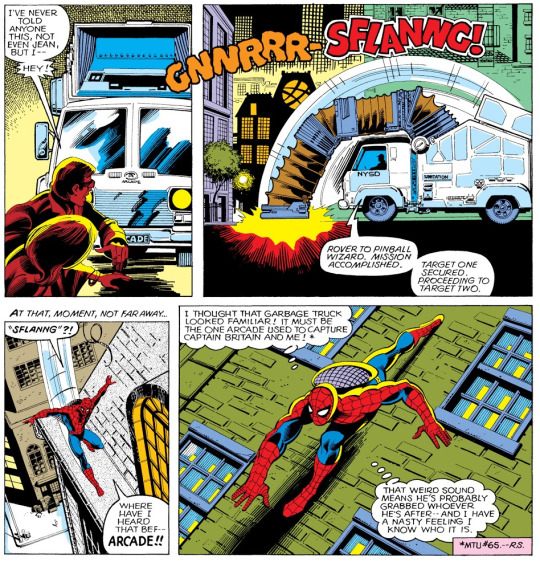
I can’t decide which is funnier: kidnapping people by sneaking up on them with A GARBAGE TRUCK or the fact that Spider-Man deduces this is Arcade’s doing by the noise alone. (X-Men 123)
Spider-Man doesn’t really figure into the rest of the plot, by the way.
Arcade successfully kidnaps all of the X-Men (and their dates: Colleen, Amanda and Betsy). Who is this Arcade? Well, he is an assassin who lets his victims run through a gauntlet of some sort, testing them with potentially deadly results in his Murderworld. He’s like a discount-combo of Saw and the Joker, except a lot less competent and a lot more spoiled rich kid. He barely kills anyone, ever, until maaaybe Avengers Arena, some forty years later.
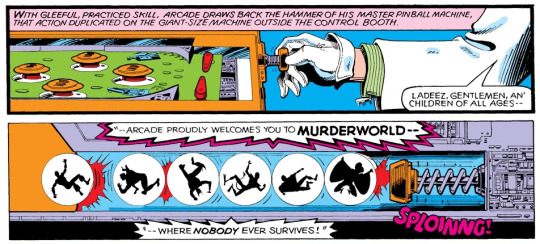
Arcade veers heavily to the silly side of the silly-to-sinister scale, but he at least commits to a theme. Bonus is that trapping your heroes in a bunch of ricocheting balls fubars them ever-so beautifully. (X-Men 123)
This whole adventure is very silly and has very little bearing on the overarching plot, but it’s a fun enough romp: Cyclops nearly gets squashed by a hydraulic press, Nightcrawler gets attacked by bumper cars with chain saws attached to them, stuff like that. The absolute best part is when Colossus is hypnotized by an illusion of the KGB and becomes THE PROLETARIAN.
His insignia is Vladimir Lenin, y’all.
After various shenanigans, everybody is freed from their respective booby traps, everyone except Colossus. See, Piotr has been feeling down, torn between the exciting new loyalty to the X-Men and the more dutiful loyalty to his family and his motherland. (Also, he’s been feeling like a failure because he came up short a couple a times, aw.) Those feelings are exactly what Arcade has been abusing, but when Colossus comes in for the kill, Storm gives the most heartfelt plea:
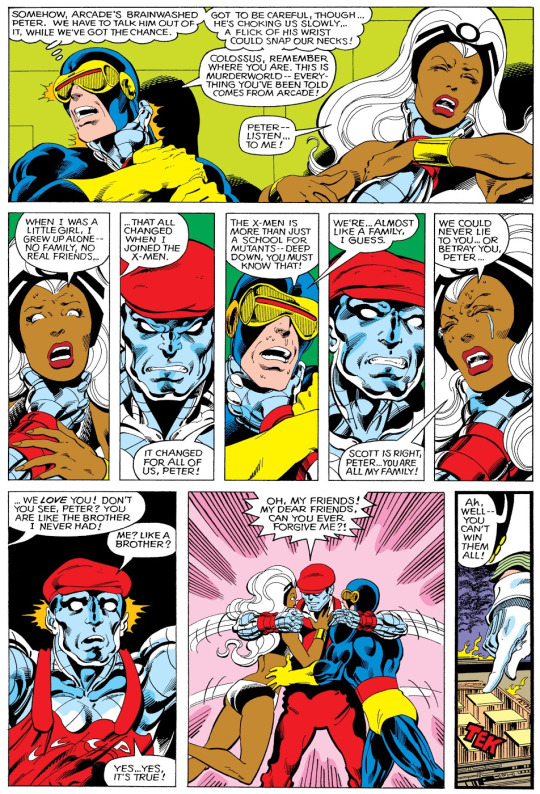
I’m not crying, you’re crying. (X-Men 124)
Arcade’s all: “Eh, can’t win ‘em all” and yeets the X-Men out of Murderworld. The story has barely any other repercussions, except we stop seeing Colleen Wing and Betsy (Piotr’s date) after this. To be fair, being kidnapped by a super villain is a good reason to stop seeing someone.
Even more inconsequential is the adventure in the Annual. The only important thing to glean from there is that, when Thor is unavailable, Storm is a suitable substitution. Couldn’t agree more.
The quality of the comic has been steadily ascending throughout the year and ends on a supremely high note: Proteus. Because I think it might be Claremont’s best work so far, I’ll be dedicating a full post to that. (Man, that 10-picture-limit is a real bummer, huh?)
Ugliest Costume: I don’t care, I just want someone to cosplay the Proletarian.
Best new character: There’s actually a few options - Snowbird, Northstar, Proteus - but both Jean-Paul and Narya don’t really show their best sides this year, so I’m going in a different direction. My pick is the Shadow King. He is a very effective foil to Xavier, perhaps even moreso than Magneto. I know I rag on Xavier and his cavalier attitude to bending others to his will a lot, but imagine if you had his powers: wouldn’t you just make people do whatever you want? Just, like, all the time? The Shadow King is an effective reminder of what Charles would have been like, had he been immoral. (Well, more immoral.)

No matter how cool your psychic battle may be, this is what it looks like to the rest of the world. (X-Men 117)
Turns evil: Colossus, for the first time!
What to read: 117, 125 - 129.
#abridged x-men#x-men abridged#cyclops#phoenix#storm#colossus#wolverine#banshee#nightcrawler#Terry Austin#George Perez#chris claremont#john byrne#arcade#colleen wing#luke cage#lilandra#mariko yashida#the shadow king#alpha flight#sunfire#vindicator#snowbird#aurora#northstar#shaman#sasquatch#professor x
33 notes
·
View notes
Text
Andy on Asian Animation or SYAC: The Master Review 2
Let’s talk a bit about anime and Dobson’s work relation with it.
I think we can all agree, that starting from the late 90s and early 2000s on, anime and manga became extremely popular in the western world. Sure, Japanese animation was nothing completely new to us (Speed Racer, Nadia-Secret of Blue Water, Samurai Pizza Cats, Sailor Moon, Kimba and Akira e.g. come to my mind as properties already known in the west before 1995) but it really was around this time that thanks to “mainstream” stuff like Dragon Ball and Pokemon people became aware of how different Japanese animation was from western. Eventually resulting in the really good shit (like Cowboy Bebop, Black Lagoon, Kenshin and Heat Guy J) coming over and enriching nerd culture for more than just a few people who knew of it as an obscurity at that point. Now, if you know anything about Dobson, you likely know that his relationship with anime is rather… complicated to say the least. Or, to let him explain it with his own words…
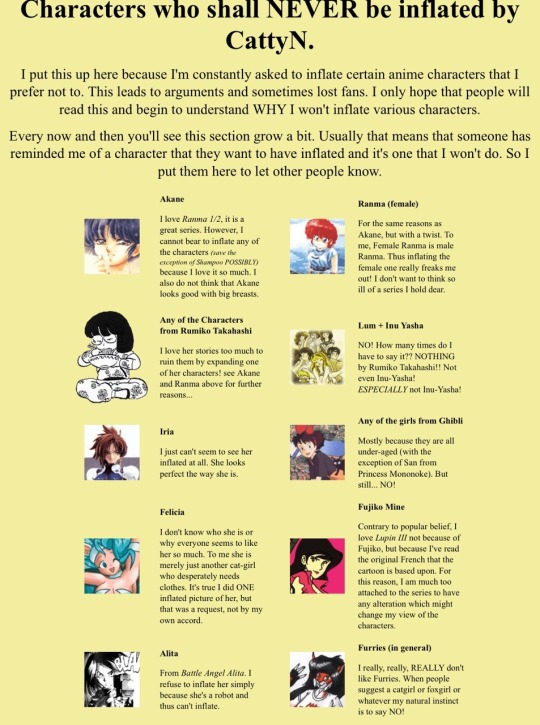
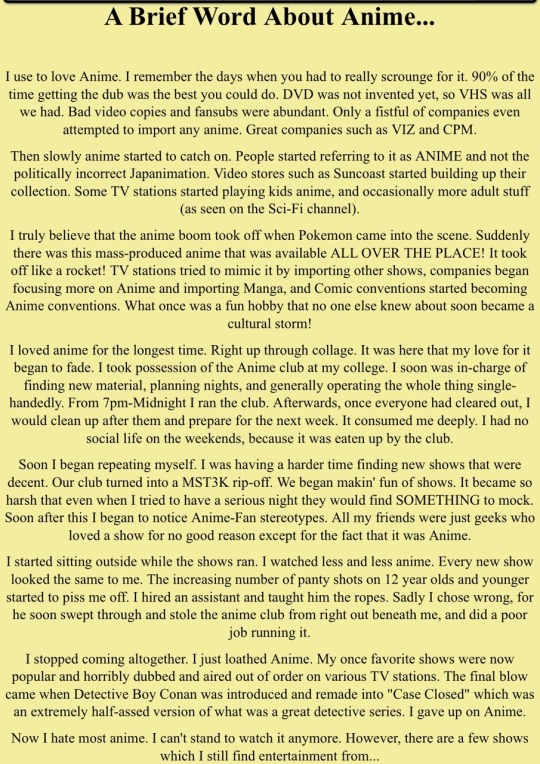

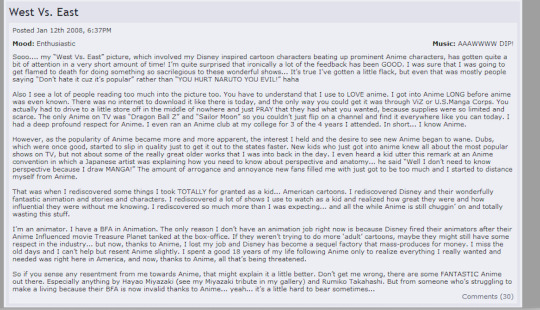
Dobson essentially likes silly and wacky 90s anime. But later on he hated anime in general, because it got too popular and a bad experience with an anime club in college soured his enjoyment of it. Furthermore, he put the blame on his lackluster art style and storytelling capabilities as seen in the likes of Formera, Patty and Alex ze Pirate, on anime in general, while also claiming that Disney pulling the plug on 2D animation is the result of the “anime inspired” Treasure Planet, meaning anime in a sense deprived him of his chance at working at his dream job and “ruining” western animation.

Which to me has always been ignorant as fuck. For starters, I can understand not liking certain stories or genres, either for objective or subjective reasons. But to hate on an entire nation’s form of entertainment (not just individual shows or genres), depriving yourself of the chance of potentially watching a lot of good stuff while also being rather insulting to these other works and people enjoying them? Especially when the stuff you can supposedly “stomach” has been rather simplistic compared to other things?

Second, blaming Japan for “poisoning” your art style? What, did the ghost of Osamu Tezuka possess you and FORCE you to put sweatdrops on your characters forehead while also going for the rather simplistic character style of Rumiko Takahashi, as well as emulating the slapstick of the likes as Slayers and Ranma ½?
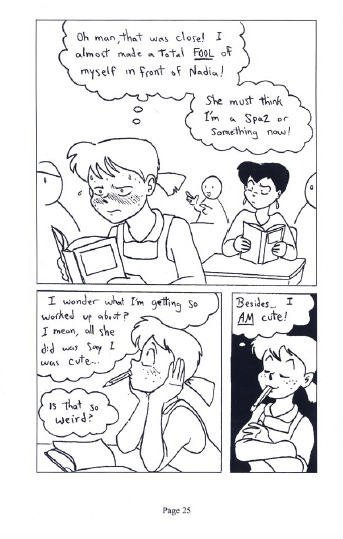
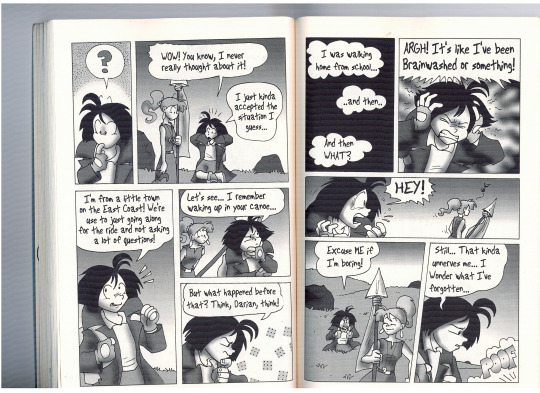
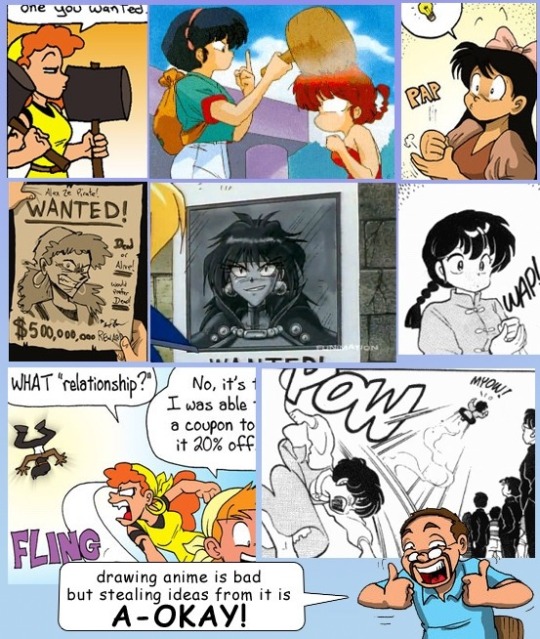
Next, if he had emulated them successfully, I say he would have actually managed to tell decent enough stories worth to read online. Not create Uncle Peggy aka “Discount Happosai” or the bland proto-Isekai known as Formera.

I mean, let’s give some context here: There have been people who successfully managed to emulate certain anime and manga aesthetics into western animation and make it work. Otherwise we wouldn’t have gotten the likes of Avatar-The last Airbender, Samurai Jack, the Animatrix, Thundercats 2011, Super Robot Monkey Hyperforce Go, Kim Possible, W.I.T.C.H, Megas XLR and Wakfu. You know, shows that are actually awesome as hell.

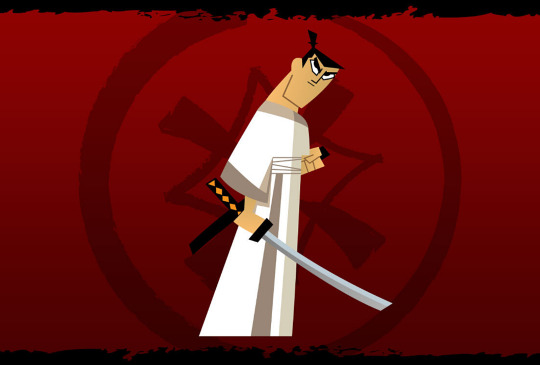
Heck, Dobson’s favorite animated show of the last decade, Steven Universe, is heavily inspired by anime aesthetics to the point of being embarrassing.
But Dobson… well, he emulated anime aesthetics in his work the same way as these crimes against animation did.
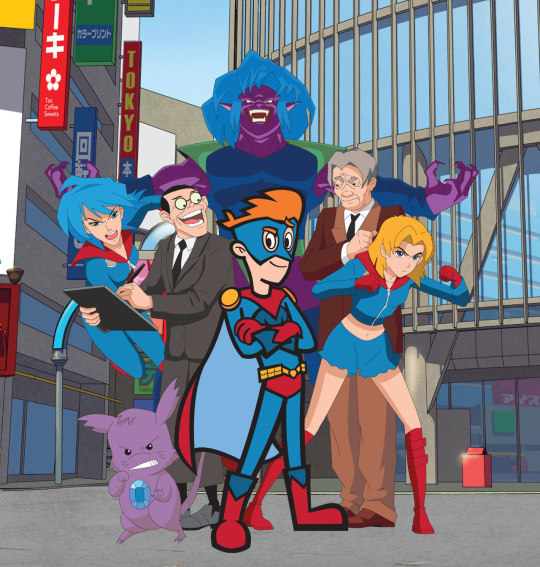
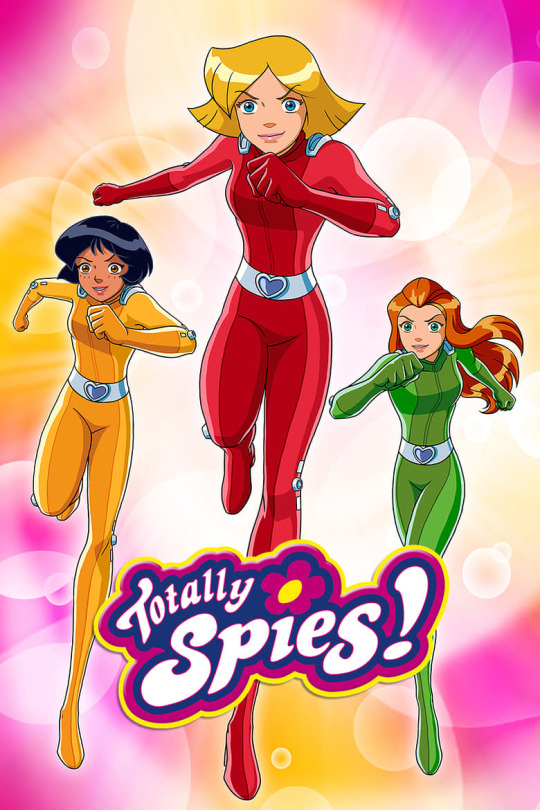
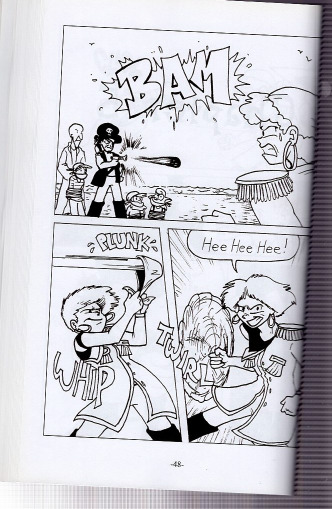
Combined with his general shortcomings as a storyteller it is no wonder his initial comics did not do well.
Lastly, and sorry for digressing here a bit, but if the Wikipedia entry on Treasure Planet is something to go by, there was no real inspiration by anime involved in making this movie.
Supposedly the idea of making an animated Treasure Planet in outer space movie was already pitched by Ron Clements WAY BACK in 1985 but only came to be after Michael Eisner greenlighted stuff in the late 90s. Design wise the movie was supposed to look 70% traditional and 30% sci-fi inspired and people took inspiration for the art style by illustrators associated with the Brandywine School of Illustration. A western style of illustration established in the 19th century, that had a big impact on the illustration styles for many 19th and early 20th century adventure novels and short stories.
What, is anime supposed to be the only form of animation allowed to have sci fi elements or steampunk in it? Fucks sake, The Lion King and Atlantis, which came out one year earlier to Treasure Planet, were likely more inspired by anime. Don’t believe me? Watch Atlantis and then a certain anime by Studio Gainax called “Nadia-Secret of Blue Water”. Or read up on the controversy surrounding the two.
The truth is, it is not entirely clear what caused Disney to shut down 2D feature film animation in the early 2000s. In fact, if anything, most people put the blame on Michael Eisner and a certain change in the publics taste in movies in general, combined with Disney trying to turn almost every movie they had into a franchise via cheap follow up movies on video and DVD.
And even if Disney did not shut down, are we really supposed to believe that a certain guy with fedora would have made it big at Disney to the point Alex ze Pirate would have been made into a feature film?
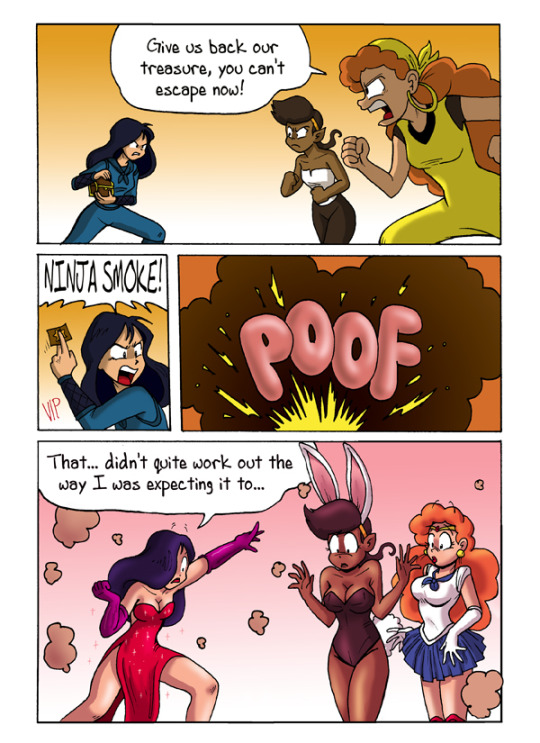
But Dobson could never quite understand this and instead of “reinventing” himself properly, he would rant about anime and its fans in one form or another…

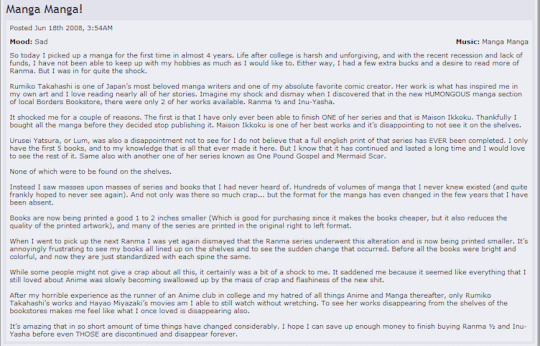
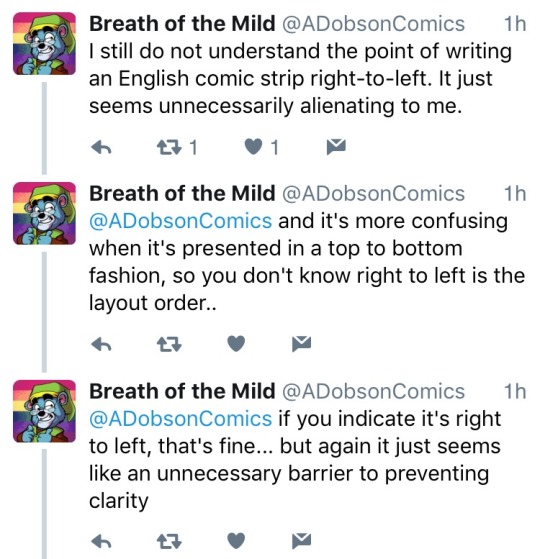

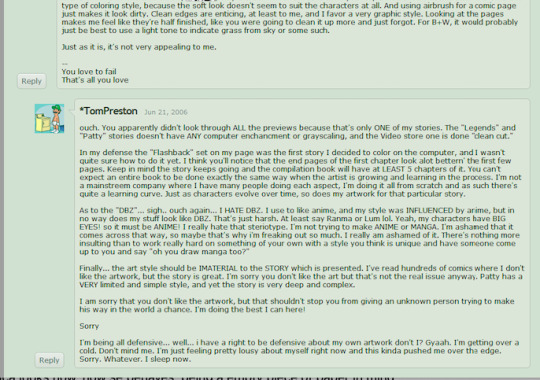
And on the peak of his hissy fit create this little art piece he baptized Anime Sux. Alternatively “West vs East”. Or as I like to call it, slap a jap.
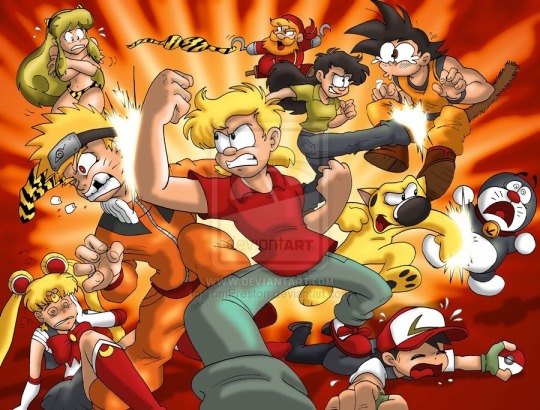

Now, the pic was done in 2008 and Dobson claimed sometimes in the last decade, that he no longer holds his old opinions. Unfortunately, by that point he would also more or less use the chance to vent in his webcomic about anime (or rather its fans), which brings us finally back to SYAC.
While Dobson never outright thematized in more detail WHY he hates anime and manga in SYAC (likely cause if his comic reasoning was even slightly like his reasoning in his blogs, people would have torn him apart like a bag of paper) he did use the format to punch down on anime fans and their preferences.
For example, for someone who has a 4chan story going around of having been rather arrogant towards others in college for not liking Ranma ½, Dobson has THIS little college related comic to show off, where he portrays an aspiring manga artist as a delusional jackass.
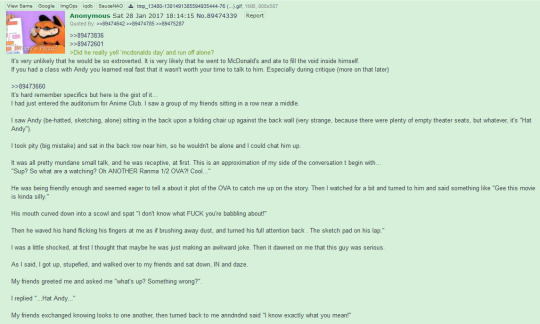
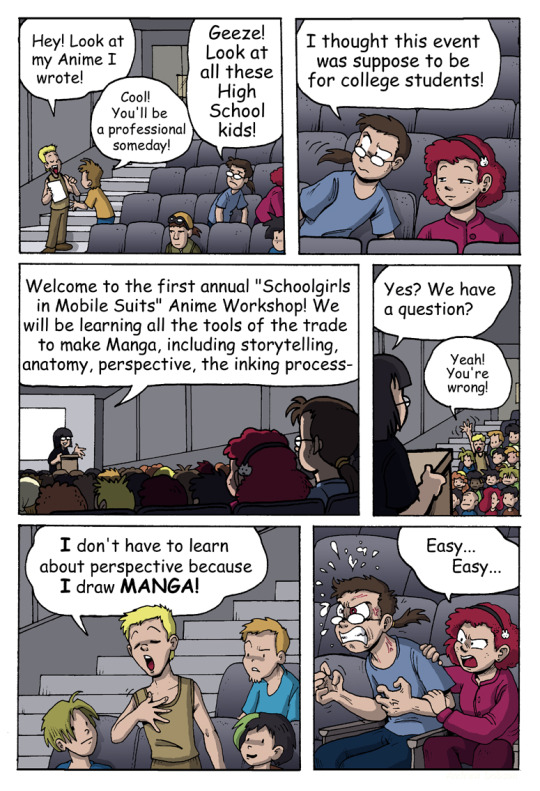
Then in this strip titled manga, his manga fan is essentially portrayed as a young woman dressing up like a very stereotypical high school anime girl, who is in the wrong for even just DARING to draw her comics in the direction manga are read.

On one hand, I get Dobson’s point. She could be at risk of alienating a market of readers as she is obviously drawing for a western audience. Then again, if she doesn’t draw a traditional western comic but a manga, why shouldn’t she? I mean, as long as she enjoys it, which I assume she does as she seems genuinely just happy when stating that she likes manga, why not let her? Plus, this comic was drawn in the late 2000s. I think by then most people kinda knew how to read from right to left, so Dobson’s claim she would alienate or confuse people is kinda redundant. If anything I find a) Dobson getting angry at her just very petty (just let her have fun) and b) portraying a western manga fan as someone who would be confused by the sheer idea of reading stuff from right to left is also in itself just really dumb and insulting. What is Dobson trying to imply? That anime fans are so stuck in the way they consume certain media, they can’t act according to “western standards” again?
Then there is this strip where yet another female anime fan is essentially portrayed as the embodiment of how “ignorant” manga fans are of the idea of different art styles...
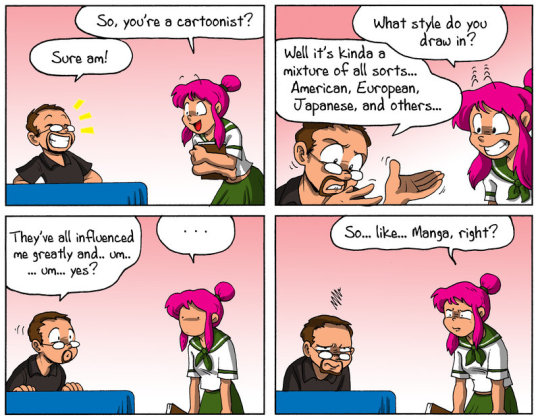
Which becomes rather laughable once Dobson describes his style as a mixture of European, American and Japanese. Why? Because he is the one oversimplifying things, rather than the anime fan.
You see while anime and manga of all sorts do share certain aesthetics (like the black and white art style, emphasize on the eyes of characters, the way hair is drawn, recurring tropes within certain genres and so on) style wise (both in art and storytelling) there can be severe differences, depending on the artist alone. Akira Toriyama’s style differentiates significantly from the likes of Eichiro Oda, Rumiko Takahashi, Kentaro Miura, Tezuka, Kaori Yuki and so forth.
The same also goes for many western artists. Herge had a significantly different style from Uderzo and Goscinny. Don Rosa has a different style in which he drew Scrooge McDuck than Carl Barks did. Rob Liefeld and Jim Lee draw mainstream superheroes differently compared to how Jack Kirby, George Perez and others did. Heck, Ethan Van Sciver and Jim Lee were closely associated with Green Lantern in the 2000s and look how they differentiate.
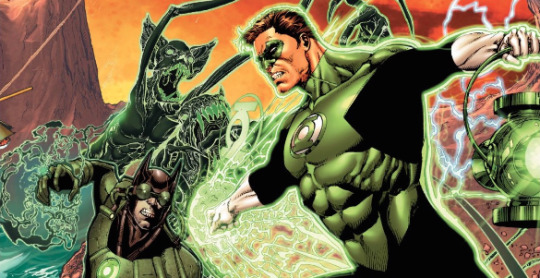
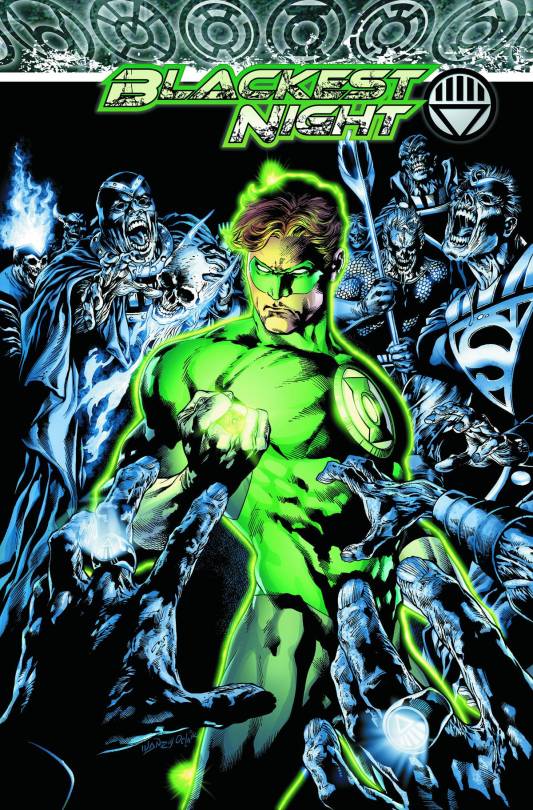
Which btw is the kind of skill level Dobson would have needed to have, to make it in the mainstream industry
So when Dobson says “I draw in a combination of American, Western and Japanese” all I can think is the following: THAT DOESN’T NARROW IT DOWN! WHAT THE HECK HAVE YOU LEARNT IN COLLEGE ABOUT COMICS? WHICH ARTISTS, WORKS AND STORYTELLERS DO YOU TRY TO EITHER EMULATE OR HAVE BEEN INSPIRED BY?
Then there is this little thing…
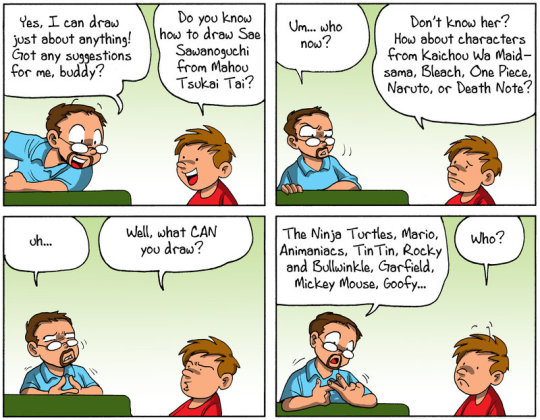
Where do I even begin? How about the fact that Dobson’s hand in the last panel looks like he has lost a thumb? The fact that the little boy, anime fan or not, is aware of Sae Sawanoguchi, a character from a short lived OVA and anime series from the 90s, which considering his age, I kinda doubt he would be aware off. Unlike Dobson, who got into anime in the 90s and admits in fact within the posts I loaded up earlier, that he had watched the anime in particular, known in the west as Magic User Club.
Then there is the implication by Dobson, that anime is so “corruptive” as a medium, little kids don’t even know the most basic characters in western animation because of it. I expect in a next panel, that all of sudden some 50s PSA guy comes along and lectures me that if I want this kind of thing not to happen at MY convention, I need to teach little kids more about the GOOD western animation, instead of the BAD eastern one.
Then there is this rather unflattering portrayal of a shonen ai/shojou ai fangirl…
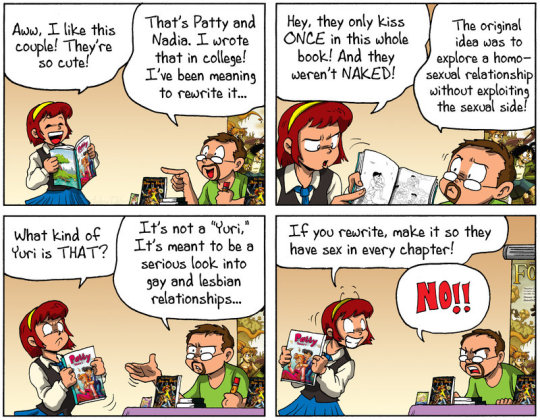
Which makes me laugh cause honestly, even some of the worst shonen ai and shojou ai can do better in portraying a “realistic” gay relationship than Patty if you ask me.
Also, as much as I think fangirls can be extremely thirsty (I have read my fair share of extremely stupid yaoi and yuri fanfics) I think that in hindsight Dobson is really not anyone to complain about shipping obsession and sex when he himself has KorraSami, the Ladybug fandom and a certain rat pirate under his floppy belt.
As you can imagine, Dobson would get heat for those comics, considering how he himself has been greatly inspired by anime and manga for his major comics. And while I don’t have any explicit deviantart posts of him reacting to criticism in that regard, I do have this comic which addresses it directly.

And yeah, if I were schoolgirl number 4, I would just sigh and walk away after telling Dobson that his mistakes and shortcomings are not related to having consumed anime, but rather by what sort of anime (and other stories) he had consumed and the amount of effort he had put in creating his stories instead of emulating just something more popular. Plus, if you really want people to draw more from life, how about drawing more from life yourself down the line? And no, tracing Star Wars movie frames does not count.
Finally, Dobson, considering how very little most people think of your work, I say mission accomplished: People have learnt from your mistakes and know not to be a Dobson.
And at last, there is this comic, which kinda wraps up Dobson’s “vendetta” with anime and manga fans within the pages of SYAC.

By trying to mock anime fans and make them look just as shallow as he is. I at least suppose. Honestly, the message of this comic is rather muddled. On one hand, I would say the strawman accusing Dobson hates anime just because it is popular is very simplified. After all, Dobson has made his reasons for not liking anime clear in a few more details.
It’s just that the details in and on themselves in real life are still rather shallow and boil down to a lot of personal bias rather than an objective criticism of actual flaws. Which I think is worth pointing out.
But frankly, what is Dobson trying to say or point out here? That the strawman is not so different or even dumber than him, because he hates Justin Bieber for “shallow” and superficial reasons too?
Okay, this doesn’t quite work as well as Dobson wants. First, the argument Dobson’s strawman makes is in huge parts based on some verified statements Dobson made for not liking anime. Second, he just says a name and that triggers the guy to express his hatred for Bieber. We don’t know why the guy hates Bieber and you could make in fact the case, that he hates him not because he is popular, but because he has a genuine issue with the artist, his work or his behavior as a human being. Third, if you want to make yourself look like the better person Dobson, try to argue with the guy and make solid arguments why you don’t like anime. Instead you just deflect the criticism by changing the subject and then try to make yourself look like the “smarter” person in the room by mocking your critic in the most condescending manner.
Which as I think about it, sounds like your modus operandi on twitter and tumblr.
Weirdly enough, that more or less marks the “end” of Dobson tackling anime fans and the beef he has with them within the pages of SYAC. Despite how much Dobson’s negative reputation especially in early years was build around him hating on anime and belittling its fans, he didn’t really do more afterwards in the Dobson focused pages of SYAC. And mind you, those strips were also separated by other strips in-between, focused on Dobson just being at conventions.
Unfortunately for him, the strips didn’t really help in any way to diminish that negative reputation and instead just confirmed for many, that Dobson can’t handle criticism about his flawed opinion on anime. If anything, it just made people think even less of Dobson, as the strips just painted him as someone who would rather portray his critics as strawman he can be “rightfully” annoyed at, instead of fellow humans with slightly different tastes in entertainment, who are still worth listening to.
So, now that we have the anime fan related “annoyances” out of the way, what other sort of silly problems in making webcomics would Dobson cover in his strips and are “relatable” to everyone?
Lets see some of these examples in the next part.
#anime / manga#manga#Andrew Dobson#fuck you Tom Preston#Tom Preston#syac#so...you are a cartoonist#so you are a cartoonist#review#webcomic#comic#adobsonsartwork#adobsoncomic#adobsonartworks
22 notes
·
View notes
Note
Hello, I read and loved your last post. I know this is not what it was about but you mentioned it later on briefly that there is a difference between BIPOC groups of the same basic descent. When is it appropriate to distinguis between?
When is it okay to talk about different varieties of cultures?
When it comes to Representation.
Will try to make this as SPECIFIC and detailed as possible with examples.
In cases where unity among an entire ethnic group is promoted, it may be counterproductive to insist on dividing or differentiating between a group. Similarly when one is referring to a culture, the place of origin and its entire diaspora fall under that culture. (For example when Indian and African culture is discussed usually, the diaspora is not separated as they are also considered Indian and African or descended from them, so they are also part of the culture.
The diaspora here meaning people who are descended from these groups, mixed with these ethnicities or grew up in the cultures outside of the country of origin.)
example: Ordinarily, people of Asian descent or of the Asian diaspora all refer to themselves as Asian, and this can be done without distinguishing the region of Asia or the country or culture, because it’s a broad term to describe people of or descended from people of Asia. It is also used by people who know they are of Asian descent but are not exactly sure what part of Asia their ancestry lies. This does not mean they’re not Asian. Some people are just not able to trace the exact origin of their family beyond the broad term, and it would be unfair to tell them they aren’t Asian or aren’t Asian enough because of this. The same could be said for European people and those descended of them. There are different countries with different cultures and there is a European diaspora as well but they can also all choose to identify broadly as European, because they are.
When speaking of Representation, however it is important to note differences to avoid interchanging and erasing some cultures in favor of others, because when it comes to representation SPECIFICALLY, every cultural group does not represent each other.
Even if you belong to one variety of culture in a broader ethnicity, for example what is acceptable for Indo-Caribbean people may be unacceptable or offensive to Indians from India. This is not to deny the cultural similarities between them, but acknowledge the cultural differences make them all independent of each other and worthy of note. Not to divide them, but to compare them.
For example, when talking about Latin America on a whole any examples may be used, but when a role calls for representation for an Argentinian person, a Costa Rican person would not be ideal because while they’re both Latin American, they are not the same, two different countries and cultures
Another example is the diaspora of African people globally. The movement of Pan-Africanism calls for unity among all Black people around the world, and in a case like that, it may not always be appropriate to differentiate or separate each person.
However, when it comes to representation, and the role calls for a Caribbean Person, it cannot be accurately filled by an American or European or Asian person who does not have Caribbean roots, but it can be filled by an American or European or Asian person who does unless the role explicitly states the character is strictly from the Caribbean with no other influence.
It is not gatekeeping or saying they aren’t “Caribbean enough” to say that someone without Caribbean roots cannot represent Caribbean people, or to say that someone who isn’t Caribbean, and isn’t of Caribbean descent whatsoever is not Caribbean, because they’re not.
I don’t know why people fight and argue this point. If you’re not you’re not, and it doesn’t make you better or worse than anyone who IS. It just means you may not be right for a role.
Similarly, if a role calls for a Trinidadian actor, casting a Trinidadian-American is appropriate unless the role specified the character is born and raised in Trinidad, but casting a Jamaican-American or Jamaican person is absolutely a problem because they’re different cultures and doing so promotes the interchanging of unrelated cultures that leads to stereotypes, ideas, preconceptions, perceptions of attitudes and beliefs from one culture being imposed on people of a completely different culture who have nothing to do with it. As a Trinidadian person, I’ve had so many non Caribbean people say “yeah mon” to me although in Trinidad that’s not our slang.
Doing this is what leads to cultural misinterpretation and misrepresentation.
African American and Afro-Caribbean people are of different cultures, countries and speak a different language entirely. By using an African American person (who does not have Caribbean roots) to represent an Afro-Caribbean person, it results in erasure of Caribbean culture because while they are both diaspora culture African groups and cultures, they are very different and cannot be interchanged or substitute each other. And vice versa.
In Disney’s The Little Mermaid as revealed in an interview with Samuel E. Wright, Sebastian was intended to have a Trinidadian accent, but as the actor couldn’t do it, they told him to just do a Jamaican accent because they felt there was no difference, when in fact Trinidad and Jamaica don’t even speak the same language. (According to Communication Studies Syllabus by the Caribbean Examinations Council for the Caribbean Advanced Proficiency Examination)
This would also be true if a character is meant to be from an African country, and assuming they were also meant to be Black, were played by an African American person (without ancestry from that specific country) or an Afro-Caribbean person (without ancestry from that country). There would be erasure of accent, culture, and even mannerisms as what may be normal in America or the Caribbean may not be acceptable in that African country, something I learned in my university History course AND Linguistics (Phonetics & Phonology) course
Similarly, refusal of people to acknowledge the differences between the cultures of the Caribbean islands is why SO MANY NON CARIBBEAN PEOPLE think that all Caribbean people are Jamaican or have Jamaican accents when all the islands in fact speak a different variety of Creole altogether. The refusal to let Caribbean people fill Caribbean roles also adds to this, because people who don’t know any better tend to give every Caribbean character a Jamaican accent, examples below:
(See Ajay Chase, Haitian with a Jamaican accent/ and George, Guyanese with a Jamaican accent/ Sebastian the Crab, Trinidadian coded with a Jamaican Accent)
Again, this distinction is drawn for the purpose of accurate representation because this is an appropriate context. However, if the matter at hand was regional integration then similarities would be examined over differences; so this is just to remind you that there’s an appropriate time and place to do this. Don’t go throwing this at people randomly, you asked me about a specific time to do this and I am answering.
Another reason why it’s important to research a specific culture when creating a character is because you can say you are creating, for example, an Indian character, but There are separate cultural groups in India as well and customs vary throughout. If you treat them as generic, you may add elements that are offensive. This is because what may be acceptable in one Indian culture may be a taboo in another one, and so cross-breeding these cultures may cause problems when people from the actual cultures encounter your character.
Even AFRICA isn’t one country with one culture, the different tribes possess different cultures, and therefore when creating African-coded characters it is better to focus on a specific tribe instead of combining random “African” (which is again not a country) elements. Every African culture is different although the people are all African. If you are referencing African culture it’s best to focus on a specific country THEN focus on a tribe from that country, instead of copying and pasting elements cut and dry from every tribe and mashing them together; some tribes don’t have a friendly history with each other and it may be offensive to just combine their elements.
Similarly, when the recent hate crimes against Asian Americans are being spoken about, it is important to make the distinction that the most recent victims are East Asians, because Asian is only a broad category that does not make a distinction between Asians based on region. People that look East Asian as opposed to those who look like they’re from another part of Asia might be more at risk for a COVID-19 motivated hate crime, because people do see a difference. (Although these racist people believe that anyone that appears East Asian is Chinese because they can’t tell the difference, they can differentiate between someone who appears to be South Asian and someone who appears to have features that are more East Asian; putting that specific group at risk.)
Just like if a role just calls for an “Asian” character anyone from any Asian country can be used, but if it calls specifically for East Asian, it would be misrepresentation to put an Indian person in that role if they aren’t mixed at all, and if it calls for someone who is 100% East Asian, then in theory it would be misrepresentation to place someone who is mixed or from another region of Asia to fill that role, but anyone from any East Asian country may be cast.
If the role is narrowed from East Asian to Japanese, then a distinction must be made between East Asian actors. A Chinese or Korean person in the role instead would be misrepresentation, because the role calls for a Japanese person, even though they all fall under the general term East Asian, which falls under the general term of Asian
It isn’t gatekeeping, it is what is required under the topic of accurate representation. By saying that differentiating between different BIPOC cultures is unnecessary because “they’re all BIPOC”, it gives room for people to misrepresent them and interchange them.
Representation is where we have to make these distinctions; but remember there is a time and a place to do so.
It’s not gatekeeping to say that if you are DEFINITELY* not part of a culture then it’s inaccurate to say that you represent it.
In fact, BIPOC can erase each other too. Pro-Black African American YouTubers constantly raise the issue of Light Skinned Black Americans and even mixed Americans being cast in roles meant for unambiguous, non mixed Dark-Skinned Black Americans. They believe it takes roles from them and perpetuates colorism because according to them, lighter skinned women and mixed women have different features and are treated differently in America than dark-skinned women, so they feel that they cannot be represented by them as they can’t relate to them; which leads to them feeling like they are being erased by members of their own group. (see video by I Am Eloho on YouTube: “Jorja Smith REMIX PROVES Bi-racial women erase DSBW” (Dark Skinned Black Women).
*Definitely here means if you are not a part of a group or it’s diaspora whatsoever. Does not apply to people who are of the diaspora because they are considered part of the group under normal non-specific circumstances
#artists on tumblr#art#artwork#digital art#digital illustration#the arcana#the arcana apprentice#the arcana game#drawing#the arcana oc
22 notes
·
View notes
Text
Medium & Marketing for 90′s Anime Dubs
Today is Hayao Miyazaki’s 80th birthday, which made sure my dash was filled with Ghibli tidbits. A discussion of my personal favourite, Kiki’s Delivery Service, brought up its ill-fated original dub by Disney in 1998. Ghibli still didn’t have the courage yet to put their foot down on changes for international releases, and so there are a lot of alterations - the theme songs are changed to be anglicized, almost any “dead space” or quiet moments in the film have someone (normally animal sidekick Jiji the cat) improv lines over the scenes to liven them up, and in particular the ending is changed to be less bittersweet as Jiji, who in the original Kiki permanently loses the ability to talk to as a sign of growing up, regains his voice.
These changes slot neatly into the zeitgeist of all 90′s anime changes - a disregard for the property’s core appeal as they were bowdlerized for a western audience. Sailor Moon is an infamous victim of a similar process - at least Kiki took place in fantasy Europe, the Sailor Moon dub’s attempts to pretend that the show doesn’t take place in Japan were simply insane as they cut out or blurred every appearance of Japanese writing in the show, leaving reams of animation frames on the floor in the process.
(Tangent time: the greatest scene ever is one where, upon reading a note by Usagi, to prove it was her Minako/Sailor Venus comments “it must be from her, its written entirely in hiragana”, the simpler form of written Japanese compared to kanji, which Usagi as a running gag cannot write. So in the dub they just...blur out the text of the note, and have Minako comment “I had to read it with my imagination. It's all written in funny symbols!". I distinctly remember watching the episode live when I was 12 years old and going “wait what the fuck does that even mean?” and suddenly realizing that the show was changing its own script, it was a trip of a moment)
Like most people I do malign these changes, but I am actually here to partially defend them via contextualization. The idea that American audiences would have cared that the show was Japanese is pretty dumb, but what you often hear are statements like “kids in Japan appreciated Sailor Moon/Kiki’s Delivery Service just fine, they didn’t need to change it”. That is possible, but it mistakes why changes are being made to begin with - its not the “culture of children in the US vs Japan”, its intended market via the medium of distribution.
Kiki’s Delivery Service was released in Japanese theatres in 1989, and it was the highest grossing film of the year in Japan (about ~US$18 million, man do things change). Kiki’s Delivery Service the Disney dub, was....released on VHS in 1998. VHS releases and movie theatre releases aren’t really intended accomplish the same thing. Remember all those direct-to-video Disney sequels? Lion King 2: Simba’s Pride? Cinderella 3: A Twist in Time? Remember how they were all just garbage? Anyone looking back at them today cringes, with a few exceptions. But none of us cringed when we were 8! My partner is a huge Disney fangirl, and when she was young she didn’t even distinguish between the theatre release and the VHS sequels - it was all Disney, you just lined them up and played them in a row as the complete canon. Yes, these movies sucked partially because they were low budget, but they weren’t actually *that* low budget - and not the throwaways your memory probably tells you they were. Lion King 2? Made ~$300 million in net sales, almost as much as the original Lion King’s theatrical run.
What those Disney VHS sequels and Kiki share is the fact that their intended market was *only* children. That is the point of VHS - you put it on for your kids and then go make dinner. Its the virtual babysitter, the kids can loop it while reenacting every scene with their stuffed animals. Movies released in theatres don’t serve that role at all - the parents are paying $15 a head and they are trapped in their seats for the whole runtime. It has to entertain everyone, or you aren’t going to go, or at least not as often. VHS releases sucked because kids don’t care, they actually do enjoy the constant quippy lines and dumb jokes. That is equally true for Japanese kids - its just that Kiki’s intended audience wasn’t Japanese kids, it was “all ages” - a very different category.
The same is true for Sailor Moon, by the way. The idea that kids in Japan could “handle more mature themes like death” unlike American audiences doesn’t hold up quite as much when you look at Disney theatrical releases like the Lion King - Mufasa’s death pulls no punches, but kids didn’t mind. And Japan does have shows like Doraemon that are just as childish as the 90′s western cartoons you remember. Its that Sailor Moon’s audience wasn’t just kids.
Bishoujo Senshi Sailor Moon aired in March of 1992 on TV Asahi. Asahi was not a kids network, and Sailor Moon did not air in a kid’s block - instead in its “Anime Block”. It aired on Saturdays, at 7:00 PM. For most of its runtime, the 7:30 slot after was held by Slam Dunk, a hyper-serious basketball anime adapted from a manga in Weekly Shonen Jump. You think director Kunihiko Ikuhara was throwing in queer relationships and even trans characters, and every other villian was a half-naked seductress, because it was gonna really resonate with 8 year olds? Sailor Moon was for 8 year olds, yes...and for otaku. So, 15 year olds, lets not exaggerate here. But still, its hype, its success, came just as much from its teen and adult fans as much as its young devotees. Which was intentional - it was *marketed* that way. That's why it aired at 7:00 PM on a Saturday.
Sailor Moon’s original dub, on the other hand, aired on UPN at, yeesh, 6:30 AM?? Then on USA’s Cartoon Express at the much more reasonable 8:30 AM, and later on Toonami at 4:00 PM. All of these are kids slots, to watch over cereal or snacks before/after school while the parents are busy. You do not expect the adult in the room to be watching alongside the kid, or for teens to really be paying attention.
And to cut off the logical objection, a show like Sailor Moon was just not going to get a 7:00 PM Saturday slot in the US in the 90′s. Nor was Kiki going to get a movie theatre release in 1998 of any scale. Movie releases are expensive, Saturday slots are precious, the funding just wasn’t there for something so untested as Japanese anime. There was no demand in the west for it - that demand would only be created later, by a generation who grew up on, well, shitty Sailor Moon dubs and Kiki VHS releases. And what success in the media slots these shows and movies did have are shaped by those market niches.
I don’t want to be over-deterministic on this - at some point Cartoon Network rolled the dice on Cowboy Bebop and Full Metal Alchemist and it worked - maybe they could have done that in 1995 with like Neon Genesis Evangelion, who knows! And of course US children’s cartoons are, beyond market forces, burdened with regulatory moralizing that Japanese media does not have. But I do think these 90′s dub efforts should get the proper context for the constraints they were operating under, and why they existed at all, as they are criticized.
28 notes
·
View notes
Text
Ultimate^2
Super Smash Brothers Ultimate has finally unveiled its final DLC character, with reactions ranging fully across the spectrum. Hot takes abound.
I mean, statistically, just about every possible opinion is going to be represented. There were at least 500,000 people watching the reveal stream, and that’s not including those viewing through restreams. That’s insane for a trailer of any kind, let alone for a console-exclusive video game DLC.
Now that it’s been like… a day and a bit, I think most of the spciest takes have probably been made, which is the perfect time for me to chip in with my own milder opinion. More of a butter chicken, really.
(no images in this one i’m lazy tonight)
I figure I’m this late already, might as well drop some notes on the other ones first.
Piranha Plant was kind of the definition of an unexpected pick. Not only was it from an already well-represented franchise, being fucking Mario, it’s also just…not a character. As such it makes an odd choice for a DLC fighter…except for the part where it was free. If you owned the game in its first month. And frankly, I don’t think people would have been happy if it wasn’t. As it is, though, it’s a perfectly fine character- surprisingly cute, actually.
I’m unsurprised about Joker’s inclusion. With how huge Persona 5 became in both Japan and the west, capitalizing on it to make a shitload of money makes perfect sense. The character plays well enough, though the meter gimmick was kind of a daunting sign of things to come. All that in mind, though, the most surprising thing about Joker being in the game is that they still haven’t put P5 on the Switch. Atlus please.
Hero and Banjo/Kazooie were announced on the same night, and I distinctly recall someone saying that this was one for the Japanese audience and one for the Americans. I mean, I’ve never played Dragon Quest, so I guess I fell into the latter? Both series have a long, well-regarded pedigree (Banjo’s lack of recent offerings notwithstanding), so both arguably deserve their respective positions. Hero is the much more notable character gameplaywise, though, with the incredibly complex mana and spellcasting mechanics. Complaints about RNG in Smash aren’t completely unfounded- though it has existed in the past in the form of, say, Luigi’s misfiring side-B- but I know a lot of people think Hero took it too far. If I’m honest, though, the weirdest thing is just having Akira Toriyama-ass 3D models in the game. Banjo’s gameplay is…awkward. The kit is kind of a mess, but at least the gimmicks weren’t going too hard, you know?
Next was Terry, perhaps the most obscure character on the entire list in 2021. I actually really like Terry in this game- while he’s still trying to emulate a similar feel to Ryu/Ken, the difference feels more natural, if that makes sense. Maybe it’s because I’ve never really devoted significant time to them, but Terry’s kit feels easier to work within than the Shotos when going between characters.
Finally for the first Pass, we had Byleth. I think it’s for the best that they announced the second Fighter’s Pass before this released, because if both 4 and Ultimate had ended their run on Fire Emblem DLCs then people would have been pissed. I mean, people were already pissed, but like…moreso. As someone who has played Three Houses, I do think the game is worth celebrating, but having yet another Fire Emblem Protagonist (read: basically a blank slate) in the game over all the substantially more interesting characters 3H has to offer is just really frustrating. Also the final smash looks like dogshit, like FE3H has overall worse animations than Smash for obvious reasons but I’m pretty sure this attack looked better the first time around.
FP2 opened with Min Min, which brings ARMS to the table. ARMS. The only first-party fighting game Nintendo has outside of Smash, so it looks a bit less weird next to everything else but…come on, man. I think this was the most confusing pick of all of them- the game came out in 2017, and having Min Min in Smash would serve as promotion for a sequel…which hasn’t been announced. There was a graphic novel in the works, but it was cancelled earlier this year. Oops? At least the stage was fun.
As much as playing them is awkward and complex, the Minecraft addition was fitting. Only the best-selling game around. I think people weren’t sure if Microsoft would go for it, but they let us have Banjo, so sure. I’m mostly just annoyed that they couldn’t get any of the songs from the actual game in there- like, you got one in from the fucking mobile game, but you couldn’t just get C418 on the phone?
Sephiroth is definitely one of the hype-ier releases from this pass. The character is iconic, as is his theme and his home game. I’ve never played any Final Fantasy game, but I can still respect the name. Once I remember how to spell it. The whole bossfight aspect to his release was also quite cool, while it lasted.
On the other hand, I have no love for Pyra nor Mythra. There’s so much wrong with these ones, frankly. They’re another swordy character, immediately following Sephiroth too, and they go back on Smash’s very deliberate decision to split characters like Zelda/Sheik and Samus/ZSS up (Yes I know Pokemon Trainer does the same thing but I have a lot more leniency for them). Add in their being from a JRPG much less well-known or remembered than the previous couple characters and the designs being…questionable, I have a big issue with the whole thing. This was also around when I kinda stopped playing the game in general, and they definitely didn’t help pull me back in.
Kazuya might have, though. With the exception of him and Sephiroth, all the characters from the Fighter’s Passes were pretty much protagonist-types, but this motherfucker pulses with the essence of bad guy. What I’m saying is that he’s fucking cool, and while he’s ludicrously complex, that makes perfect sense since…I mean just look at the combo lists from Tekken 7. His inclusion also kinda rounds out the list of biggest fighting game franchises out there being rep’d in the game, though I imagine now I’m going to have stans from Mortal Kombat or whatever on my back. They’re not going to put a fatality-capable character in Smash, guys!
Finally, this rounds us around to the original point of this article. Let’s talk about Sora. And by that I mean…I don’t really have a huge amount to say about him. Kingdom Hearts is a franchise that completely passed me by growing up, and I don’t think I have the time or energy to devote to it now. I’m sure it’s good, people seemed really excited for him to be in the game so they have to have gotten that love from somewhere, but I don’t share that feeling.
That’s not to say that I don’t think he deserves a slot. The idea of “deserving a slot” in Smash Bros is kind of an odd concept, even though it’s come up a lot so far this post. But a slot in this roster isn’t just a place in a popular fighting game, because at this point, Smash is kind of a museum of (mostly Nintendo) games- and so having representation is a forever acknowledgment that the franchise is, or has been, an icon to so many. Kingdom Hearts, to my knowledge, has 100% earned that position, and so Sora getting to be playable here makes perfect sense. He wasn’t my pick (Touhou representation never I guess), but I’m happy for those who wanted him.
As far as the actual gameplay looks, he reads like a character that kept in mind what people didn’t like about Hero when he released. It’s another sword-based character, which I think at this point speaks more about the demographic of video game characters than it does about Smash. But I appreciate that the Magic Bullshit is toned down, and that it’s also his only real gimmick (The 3-hit combo feature is A Thing, but other characters e.g. Bayonetta have already done that, so whatever). His recovery potential looks patently absurd- like he just gets Pikachu/Pichu’s Up-B as a Side-B that can also be chained with his actual Up-B? This guy better be light as hell or he’s going to be super hard to take out. I dunno, I think he looks solidly fun enough- more dynamic and aerial than the other swordfighters, at least- and that’s good enough for me.
And I guess that marks the end of Smash Ultimate. Not with a bang, but with a key…dude. It’s been a very solid run, the game managing to keep itself fresh across several years of development, even as other games have risen and fallen. Smash is kind of forever at this point, I think, though the finality of Ultimate’s ultimate character implies that this particular iteration may be coming to its end. And seeing as it is always one Smash per console, I wouldn’t be shocked if the Switch itself was nearing its endgame as well.
Okay but also it’s pretty funny how they heavily censored everything Disney out of Sora’s DLC except for that little Mickey charm on the trailer, like how much must that one shot have cost them, was it even remotely worth it, I don’t know but I kinda want to
#ramble#ssbu#ssbu spoilers#ssbu dlc#smash ultimate#video games#still mad they didn't put a song in with the doomguy costume
2 notes
·
View notes
Text
COMPARE & CONTRAST: Birth Of A Nation vs Gone With The Wind vs The General
TRIGGER WARNING:
Talking about race in American culture and movies, so some readers may want to brace themselves (looking at you, wypipo).
. . .
Confining “classic films” to movies that:
Demonstrate technical expertise, and
Influenced other films and creators
-- we have three (and only three) movies about the American Civil War we can safely put in the classic bin.
Before we go further,
let’s restate the obvious:
A film’s impact in the medium of motion pictures is separate from its impact on the culture as a whole.
Case in point:
Leni Riefenstahl’s The Triumph Of The Will is a perfect textbook example of how to stage massive crowd scenes for maximum visual impact, and how to promote individuals and ideas in purely cinematic terms.
It also contributed mightily to the Nazis’ rise to power, their subsequent wars of conquest, and the deaths directly and indirectly of tens of millions of human beings.
It’s important to know The Triumph Of The Will exists and why it’s important in film and cultural and political history, but you need never subject yourself to its vile hate mongering.
With that in mind,
let us proceed.
. . .
Here are the three bona fide classic movies about the American Civil War:
The Birth Of A Nation
(1915)
Gone With The Wind
(1939)
The General
(1926)
They are all problematic for the same reason:
They embrace the “lost cause” myth of Southern white supremacists.
The Birth Of A Nation is by far the worst offender of the trio, helping to restart the Ku Klux Klan and promulgate jim crow for decades to come.
Director D.W. Griffith was a Southern boy, Kentucky born with a father who served as a colonel in the Confederate army (Kentucky, a border slave state, tried to stay neutral at the beginning of the Civil War, then leaned heavily towards secession, but by 1862 threw its lot in with the Union).
Griffith bought into the lost cause myth heavily, and The Birth Of A Nation explicitly states African-Americans are fit only for slavery, becoming a murderous / rapacious mob once freed, and the Ku Klux Klan were gallant heroes attempting to turn this tide.
Griffith tries to have it both ways, depicting Abraham Lincoln as a thoughtful and compassionate leader who would have treated the South better had he survived (ignoring the fact Andrew Johnson did everything in his power to prevent the Union from holding the South accountable, and that Lincoln’s assassin was a Southerner who killed him in revenge after the war ended).
There can be no denying Griffith’s enormous talents as a film maker (again, separating thematic content from the technical expertise). While the Hollywood publicity machine was quick to claim The Birth Of A Nation was the first feature length film (i.e., 65 minutes or more), the truth is the Australians, the Chinese, the English, the French, the Italians, the Japanese, and the Russians all made feature films long before Griffith, and Griffith wasn’t even the first American to make a feature but was preceded by at least a half a dozen other film makers.
What Griffith was, however, was a master synthesis of all the techniques that preceded him. Griffith made movies better than anyone else of his era, and his best films are still eminently watchable to this day.
That’s what makes The Birth Of A Nation so harmful and destructive: Like the Riefenstahl film, it seduced common audiences into complacency while stirring the worst people to action.
It’s a film whose final cost is not measured in dollars but in innocent blood and tears.
Griffith wasn’t stupid, and while he might have felt personally immune to the criticism of his racist attitudes, he was savvy enough to recognize publicly embracing them would not serve his career well. He followed The Birth Of A Nation with Intolerance, an epic that jumps around in its story lines like a Tarantino film, and in later movies displayed a far gentler albeit still patronizing attitude towards African-Americans.
But the damage was done, the lost cause myth cemented into not just the Southern psyche but white America in general.
Like The Triumph Of The Will, I would never recommend The Birth Of A Nation as a “must see” film to anyone. If you’re a film historian and you want to subject yourself to this cancer, that’s your choice, but if you’re a student of film there’s nothing Griffith did technically or artistically in this movie that he didn’t do better in his later efforts, and other film makers have since emulated his innovations and built upon them.
. . .
For many decades Gone With The Wind was celebrated as the pinnacle of American film making, but once the romantic blinders were removed we see it for what it is: An over long, over blown epic that promulgates what we now recognize as white supremacy, classism, and rape culture.
And while it uses every technical trick in the book, it doesn’t use them as well as Orson Welles did a year later with Citizen Kane.
Gone With The Wind is really two movies: A well made Civil War epic and its lackluster Reconstruction sequel.
They should have ended the movie with “As God is my witness, I’ll never go hungry again!” (Seriously. The only two memorable scenes in the second half other than “I don’t give a damn” both center around Scarlett O’Hara’s dresses.)
Again, let’s emphasize that a technically well made movie does not excuse bad intentions in thematic content.
Gone With The Wind is a rip-roaring bodice-ripping historical novel, admittedly well research and well written by Margaret Mitchell.
She isn’t necessarily writing from a conscious desire to spread the message of white supremacy, but as a Southern gal who grew up in the midst of the lost cause myth, she ends up breathing that message into every line of the book.
The movie version can’t escape that, nor does it try to. There’s a brief scene early on where both Mitchell and the later film makers prefigure the lost cause myth where Rhett Butler explains to the good ol’ boys at the Tara cotillion that they’re about to be brutally decimated by the Union in a war of attrition, but both author and film makers side with the good ol’ boys and support their God given right to throw away their lives and destroy their homes in an attempt to keep enslaving millions of innocent people.
That last part in bold never gets mentioned, does it? As others have observed, Gone With The Wind isn’t antagonistic towards African-Americans, rather it treats them as if they don’t exist other that walking / talking props among the scenery.
In that regard, Gone With The Wind is on par with The Fountainhead or Atlas Shrugged (only with a far superior writing style). The protagonists of all three books are narcissistic sociopaths who will lie / cheat / steal / blow up buildings because the common folk -- the people who actually put in the grunt labor to make things work -- are nothing but slaves there for the elites’ entitlements, and God (or market forces, take your pick) help them if they ever raise their heads or voices -- much less their hands -- in protest.
Oh, but doesn��t it look gorgeous? As those beautiful rich Technicolor gowns and sets and matte paintings. All those balls and dances. All those smoldering looks. All those flames as Atlanta burns…
There’s the true hero of the story: William Tecumseh Sherman. The mofo cut the Confederacy in half, destroying lines of supply and communication, obliterating any rebels who dared to stand up to him, shortening the war by several months, and freeing tens of thousands of enslaved people in the process.
None of which would have been necessary if a few greedy bastards such as the O’Haras had lived Christian enough lives to say, “Y’know, maybe the way we’re treating these people is wrong…”
Gone With The Wind proved insanely popular, on a scale with The Birth Of A Nation a generation earlier, and once again it made it easier for mainstream middle American whites to turn a blind eye to injustices still being perpetuated on African-Americans of that day.
And it kept playing again and again, one of the very few non-Disney movies to enjoy a substantial re-release schedule, popping up about once every seven years in theaters until the arrival of first cable then VHS.
And it’s still popular, still a steady seller in DVD and BluRay.
That’s in no small part to the skill of both Mitchell and the film makers in hiding the most egregiously problematic elements of the story under a think patina of romanticism. It became a cultural touchstone that everyone knew and everyone could reference, from political cartoons to Carol Burnett skits.
But it’s still racist and white supremacist, saying African-Americans exist only to serve whites.
It’s still classist, saying not all whites are worthy of what the upper class hogs for itself.
It’s still about rape culture, saying all Scarlett needed was one good rape by Rhett Butler to set her straight.
Is it a product of its era?
Absolutely.
The same way over the counter heroin at your friendly neighborhood drug store was a product of its era. The same way cocaine laced Coca-Cola was a product of its era.
Just because it wasn’t recognized as a bad idea then means we should still circulate it now.
Compared to The Birth Of A Nation, Gone With The Wind is a far less hate filled work, and one that inspires less immediate harm.
It has inspired harm over several generations by making it easy to overlook the real harm it represents in favor of a romantic antebellum fantasy.
If someone wants to see a film that represents the Hollywood studio system at the height of its creative power, I’d recommend Casablanca or The Wizard Of Oz.
I’d put Gone With The Wind way down on that list, and I’d caution it with caveats, but I would say it represents a good example of the old Hollywood system firing on all eight cylinders.
At least for the first half of the film.
. . .
In most ways, Buster Keaton’s The General is the least problematic of these three films.
In another, it’s as bad as Gone With The Wind.
The good thing about The General is that modern audiences can easily enjoy it.
Buster Keaton chasing after a stolen steam locomotive? What’s not to love?
It’s one of his best comedies and if it’s not the very best, I’d hate to live on the difference.
It certainly lacks the overt racism of The Birth Of A Nation.
In fact, it almost lacks any race at all.
And ironically, that’s what makes it a problem.
In researching this post, I re-watched The General, something I wasn’t willing to do for The Birth Of A Nation or Gone With The Wind.
I re-watched it looking for African-American faces anywhere in the film.
I think I found four.
Two porters lugging a trunk in an early scene at a train station, possibly two small children with their backs turned to the camera at the edge of a crowd about ten minutes later.
That’s it.
In a movie about one of the most crucial events in American history, an event entirely predicated on the issue of the enslavement of millions of African-Americans…that’s it.
Four faces.
Total screen time: Less than a minute.
If critics can justifiably lambast Gone With The Wind for sailing over the bloodied backs of millions of enslaved African-Americans to focus on the luxury liner S.S. Scarlett O’Hara, what can they say about a Civil War movie that almost succeeds in eradicating those enslaved humans from the story?
Paradoxically, this makes The General the safest of these movies to show an unsuspecting audience.
The Civil War is boiled down to the dark uniform army fighting the light uniform army; why they were fighting is never explored in detail.
But the lost cause myth was so prevalent at that point that Keaton and company didn’t need to discuss the causes of the war.
Audiences – even those completely ignorant of U.S. history -- automatically assume the light uniform army are the good guys simply because Buster is on their side.
Buster would never do anything bad, would he?
Of course not!
And so -- =poof!= -- millions of people erased from history.
Top that, Thanos.
To be honest, I don’t know how a modern audience should react to that, in particular an African-American audience.
Disappointment at being culturally short changed again?
Relief at being spared the most egregious stereotyping and white supremacy apologies?
Or just plain enjoy Buster chasing after a stolen locomotive?
The General’s cultural weightlessness helps it become a great film.
It’s a purely cinematic endeavor, with the intertitles used primarily to explain the spies’ and military leaders’ plans and motives, not tell us what Buster is thinking and doing.
For a guy called “the great stone face” Buster could be awfully expressive with his body language, and he needs title cards the least of all the performers in this movie
. . .
So where does that leave us, as a 21st century audience in a 21st century culture?
We can neither deny nor ignore the impact of these three films. Even The Birth Of A Nation, as vile and as hateful as it is, influenced the country and the countries attitudes for a century.
Gone With The Wind feels like something we’ve outgrown, something some audience members can look back on with fondness, but not anything we can fully embrace again.
The General can still make us laugh, and in this case the sin of omission seems far less than the others’ sins of commission.
Learn from the past.
Do better in the future.
© Buzz Dixon
#race relations#movies#art#cinema#morals#ethics#politics#Birth Of A Nation#Gone With The Wind#The General#DW Griffith#Buster Keaton
7 notes
·
View notes
Photo

So it turns out that my friends all betrayed me, in that all of them let me get this far without watching a single Miyazaki film and that’s just a darn shame because holy Father Francis, this movie is amazing.
I kind of resisted seeing this movie back when it was big? In the early 2000’s, this was one of the movies that got universal praise and adulation, and since no one really bothered to explain to me what it was actually about, and why I should care, and it was before I spent all that much time on the Internet anywhere that wasn’t related to LEGO, all I knew was that there was this anime movie that people loved and nobody I was friends with back then seemed to care one way or another about it.
[Although admittedly, it wasn’t that I had a lot of friends at that point in my life.]
So it goes like this: Chihiro is a ten-year-old girl who isn’t too thrilled about her family moving to a new house. Her parents stop and explore this weird abandoned area for a while, and when they find a bunch of food they start eating, and whoopsie-daisy, they’ve been turned into pigs, and now Chihiro is trapped in the spirit world! A friendly spirit appearing as a young boy named Haku helps Chihiro stay safe, and gets her to obtain a job at the bath house, run by the evil witch Yubaba. There she can safely spend time while they work out a way to free her and save her parents.
The animation in this movie is gorgeous. I love it! I love it quite a lot. It’s very good. I know I say that about a lot of animated movies, but I can’t help the fact that I watch a bunch of well-animated movies.
The story of this film feels not dissimilar to a fairy tale--a child getting trapped in the world of fairies/spirits, and having to navigate its bizarre inhabitants and rules that are hostile to ordinary humans, while trying to save her parents. I hold that yokai in Japanese folklore behave in a way that’s very similar to the ways fairies are in European folklore, but I’m not Japanese so I could just be talking out of my butt from the limited experience and knowledge I do have.
I suspect that if I were Japanese, there are parts of this movie that would resonate more strongly with me. But I’m not Japanese, so I either have to speculate or read other commentaries and hope that it doesn’t make me feel dumb.
A particular theme that stuck out in this movie was the destroying nature of greed. I saw plenty of people commenting that this was Miyazaki’s commentary on capitalism, and maybe, but overall the film does not portray greed very pleasantly. The least sympathetic characters, like Yubaba, are incredibly greedy and treat everyone around them terribly. In the case of No Face, it infects and corrupts him into being something he’s not--Chihiro even says it makes him sick. Besides, let’s not forget that what started this mess was Chihiro’s parents sitting down and feasting on food that isn’t theirs.
And Yubaba, when she employs someone, whether human or spirit, she takes their names, and they forget their original names and who they were before. Chihiro has to be reminded by Haku what her name was the previous day. Haku doesn’t remember his own identity outside of being Yubaba’s apprentice.
[Something something, Rule of Names--I’ll save it when/if I cover Tales of Earthsea in a post.]
Greed makes us forget who we are. It’s made an entire settlement of people forget who they really are and who they’re meant to be.
Hm.
Again, don’t know if this would resonate with me more if I was Japanese, or if Miyazaki is commenting on greed in the world in general, or what. But it’s definitely a message that applies to American culture and corporatism. It sure as heck applies to the state of animation nowadays, and Disney deciding to remake its classical animated library in live action for the sake of making money!
Ahem.
I should talk about some of the characters.
Chihiro is an excellent heroine. I feel that a lot of stories aimed at children very often try to make the child protagonist too capable to be believable or too dumb to be sympathetic--usually with the excuse of, “Oh she’s a kid, of course she messes up!” Chihiro walks the fine line between those two in a way that I think works. I never thought that she skewed one way or the other, and that was relieving.
Yubaba, on the other hand, is a perfect villain for this kind of story. The image of a wicked witch is exactly the sort of antagonist for a fairy tale, and Yubaba fits it to a T. She’s not the kind of villain who instantly tries to kill the heroine, though it’s not because she can’t--when she shows her power she’s truly terrifying. But what makes her tick, and what makes her (sadly) realistic is that she’s more concerned with utilizing her power into making money for herself and controlling others to do so, not caring whose lives she’s making miserable in pursuit of it.
No Face? Is a fantastic character? Great design, great animation, just great all around. He’s unsettling, but he’s not evil, at least not in his base nature--he just becomes corrupted by the greed in the bath house. I don’t know if he’s based off of a creature in Japanese folklore, so maybe he’s not original to the film, but he’s very creatively realized on screen.
Yubaba has a twin sister named Zeniba that’s… well, she’s exactly the same in appearance, and I felt as if she didn’t get enough screen time to really get a good impression of her? At least, one distinct from “She’s mostly the opposite of Yubaba.” I did like that she wasn’t always nice--the first impression we get of her is sending paper minions to attack Haku. For reasons that are completely justified from her perspective, but still not particularly nice.
Haku’s great and I could try giving an analysis but if I’m being real with you, he’s a dragon. I love him because he’s a dragon. That’s shallow but that’s the truth. Again, he’s good, but he’s not nice; there are times, when he’s in dragon form, that you are reminded that he’s a dragon, goshdarnit, and that’s more than a little intimidating.
It’s a fine movie. It’s got fantastic characters. It’s amazingly animated. It’s got great themes. It’s a lovely movie and I’m sad I only now just saw it for the first time. Go see it if you haven’t. If you have, see it again.
11 notes
·
View notes
Text
Kamigawa was a failed endeavor. Released in the autumn of 2004, Champions of Kamigawa promised some new things for Magic the Gathering, and the return to some old things as well. Most importantly, in my opinion, it showed that Wizards was paying attention to what fans were interested in (outside of Magic) and wanted to provide a way of relating to the fans. However, just about everything they did with the setting and game either couldn’t live up to expectations or outright failed. Here’s why I think the original Kamigawa block failed, and why I think a return would be a resounding success.

This came out much longer than I’d expected, so hit the jump.
For its entire existence up until 2004, most of Magic’s settings were a hodgepodge of fantasy tropes, and the storyline had been following or tying into a single thread for years. Kamigawa was the first setting to truly be free of the ongoing Magic story. Nowadays, however, Magic is known for its settings based on real-world places and cultures. Just this past year, we’ve visited Eldraine (Arthurian Britain), Theros (ancient Greece), and Ikoria (less a real culture and more about giant monster tropes). Back in 2004, however, visiting a clearly defined theme world like this was something that hadn’t been done in a long time. In fact, it’s something the franchise traditionally shied away from. 1996’s Mirage block took place in Jamuura, a continent on Dominaria based on sub-Saharan Africa.1995’s Ice Age was set in a Viking-inspired Terisiare. (You could say that Arabian Nights and Portal Three Kingdoms also count, but those were more wholesale copies than homages.) Based on ancient Japan, Kamigawa was the first herald of a new worldbuilding philosophy for Magic, one that would see the creative team at Wizards of the Coast put their own spin on familiar cultures and mythologies, while still keeping them distinctly their own. Kind of like Disney movies.
The mechanics also promised to shake things up. While I don’t remember any of the card announcements, Kamigawa block introduced many new pieces for the game. Samurai and ninja had their own keyword abilities in bushido and ninjutsu, and most of the sorcery and instant cards dealt with arcane and spirits. Legendary had its own theme as well, with 138 unique creatures (139, if you count the other Yamazaki brother) and 39 other permanents, with a number of cards that cared about the supertype. Finally, there were flip cards, a mechanically and visually interesting way of getting more value out of those creatures and introducing a sort of sidequest to your game.
Kamigawa was gearing up to be something special in Magic. But as I said at the very beginning of this piece, it failed.
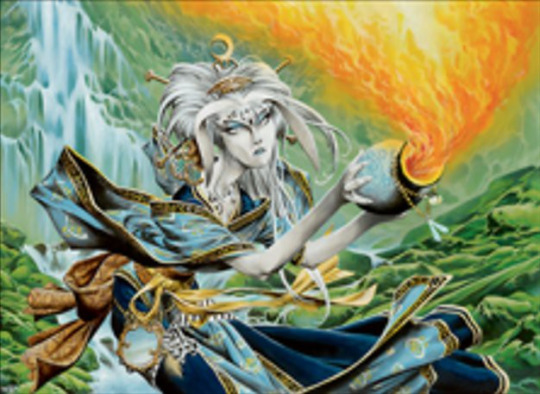
The mechanics were kind of a disaster. Splice onto arcane was parasitic and to get any value out of it, you’d need to go all-in on overcosted cards. Bushido, sweep, offering, and most of the rest of the keywords were similarly underwhelming, either providing minuscule value or actively getting in the way of what you wanted to do. Putting the legendary supertype on a card is a downside when Commander doesn’t exist and singleton formats are not a popular way of playing. It doesn’t help that having too many legendary creatures in a set thend to make them feel less special, as well. Flip cards, while cool in theory, wound up being a logistical mess that didn’t add much to the enjoyment of casual games, and barely saw tournament play. All of this meant the cards didn’t really impact Standard, and Limited was a clunky ordeal more often than anyone would have liked. Following Mirrodin block, the most powerful three sets since Urza’s block, was also a tall order, and one that almost no set was equipped to fulfill.
Admittedly, while I love the card game, I absolutely adore everything else about Magic. The storyline intrigued me when I started playing during Onslaught block, and knowing that there was this vast body of lore kept me hooked. Hearing that there was a Japanese-inspired setting coming up was pure hype for someone who’d also been into anime for years and video games for years before that. The early 00s were an interesting time for entertainment, as Japanese animation had finally infiltrated American mainstream media. Pokémon had been a successful card game for years (another story for another day), and Yu-Gi-Oh had just hit the scene in America after doing well in Japan for a few years. With all this and a burgeoning internet, fans of anime, video games, and Japanese culture had certain expectations. To say Kamigawa did not meet them would be an understatement.
The general setting was based on an older Japanese culture, one which didn’t see much representation in media. Samurai, ninja, youkai, along with other popular figures and tropes were either later inventions or had a more solidified image hundreds of years after the source material took place. While I remember many Magic the Gathering fans being worried that the game would take on an anime aesthetic to capitalize on what was popular with the wider geek audience, they actually took it in the opposite direction. Instead of bright colors and bold outlines, Kamigawa was a dark and gritty place, which was made even more evident by the increasing demand for realistic detail in the art department. The kami themselves, one half of the conflict, were alien and foreign to behold. These weren’t based on images that otaku would have been familiar with, Japanese or Western, but based on much older stories that had been phased out of the public consciousness.
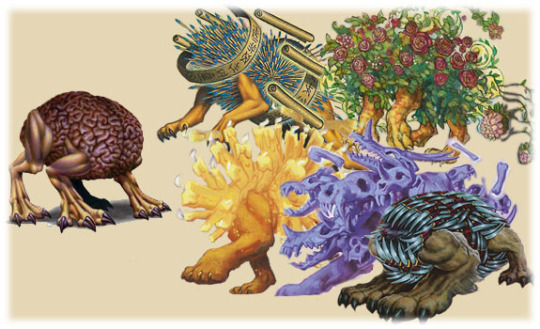
In short, there is no “in short.” There are many reasons why it didn’t succeed, but ultimately, it came down to being something that no one really expected or wanted. Instead of taking the cheap, easy, and profitable route by leaning into anime culture, Wizards bucked the trend and used a setting that most Magic fans would not have been familiar with, forcing it to fit within the franchise. They also filled the block with parasitic mechanics that were clunky and actively detrimental to play. And yes, I’m leaving out dozens of other reasons why Kamigawa failed, but those are the main ones that I personally feel hurt the setting.
Sadly, as public-facing employees remind us constantly, Kamigawa is a very difficult sell to the higher-ups. It was one of the company’s biggest failures, and they can’t use tweets and Tumblr asks from enfranchised fans as justifications for its return. And yet, the requests still pour in. I believe that the reasons for this desire are the key to a new set based in Kamigawa.
Let’s start with the biggest one: Commander. In many ways, this format is kind of the anti-MtG. It’s a long, drawn-out process that uses decks built with your whole collection, rather than the newest releases. Cards that are awful in most other formats are amazing in Commander, and one of the biggest drawbacks a card can have - the Legendary supertype - is a major boon here. It’s also the current most popular format for old and new players alike. I think that more than anything else, Kamigawa’s legendary theme is what draws new players, as Commander enthusiasts will inevitably find some interesting cards that would never have worked well in the old days.

I also think that Wizards of the Coast has learned a lot since 2004 (and whenever they started work on the original block). Remember, Kamigawa was the first of its kind: a real-world inspired setting completely separate from what the entire franchise had been doing for years. There were bound to be mistakes, and they’ve clearly learned how to rectify them. The following setting, Ravnica, used an Eastern European city aesthetic to compliment its two-color guild theme, but was still constrained by the block structure. Upon our return there, they changed the block structure to better fit what the themes and story wanted. On the other hand, Zendikar, their D&D-inspired adventure world, was beloved for its fast and fun mechanics, as well as the feeling of exploration on the cards and in the media. The return, however, involved destroying all of that in favor of an extradimensional war setting. Guilds of Ravnica and Zendikar Rising each supplied what the fans wanted out of those settings, to varying degrees of success.
Wizards also keeps showing us glimpses into Kamigawa through Core Sets and supplemental products. Tamiyo showed up on Innistrad and Ravnica. They printed new shrines (compatible with the old Honden) in Core 2021. Yuriko, the Tiger’s Shadow, is one of my favorite commanders of all time, and she’s from the 2018 Commander set. They still value the setting, and don’t seem to be interested in ignoring it to the point of obscurity (like, for example, Mercadia).
And, obviously, there are the rumors. With a blog name like mine, you have to have known this was coming. The three planeswalker concepts from surveys could point to anything: Commander products, supplementary sets, etc. However, I think that the web domains for Kamigawa Neon Dynasty point to a full set of some kind.

Interestingly enough, the events of the original Kamigawa block take place in Magic’s very distant past, so it’s been a tantalizing prospect to see how the place might have changed in the past few thousand years. Skipping over medieval fantasy and bringing it past the present into a cyberpunk future might be an excellent way to go about it. Aesthetics from early 90’s anime could still be stylistically unique in Magic, while keeping elements from the old setting would root us to the original block. I could see the new story centering around a conflict between one faction clinging to ancient traditions and another pushing magical technology to its futuristic limits. After all, Tamiyo still dresses in old-fashioned robes and reads from scrolls, and the moonfolk were known to be almost completely isolated from everyone else. I wonder what the kami would look like, if we even saw them at all.
Ultimately, I think that Wizards is in the perfect spot to try Kamigawa again. Between their worldbuilding experience, the rise of the Commander format, and a willingness to push the aesthetics of their game in different directions, there’s a lot of reason to hope that we’ll be heading back sooner or later.
Please feel free to let me know if I missed something or got any details wrong. And please discuss what you’d like to see in a return to Kamigawa, either new stuff or old.
9 notes
·
View notes
Text
Late night thoughts #1 — KnY demons and Disney
It's currently 6am here and I haven't been able to fall asleep yet so this still counts as late night thoughts, right? Well, even if not, just enjoy the crack please.
Also, when talking about movies that have been remade, I'm taking the old versions, I haven't seen any of the remakes yet and I'm not exactly planning on it either.
Muzan
Honestly prefers Dreamworks over Disney, especially their earlier works.
Probably still enjoyed Great Mouse Detective or The Black Cauldron. Oh right, and Hunchback of Notre Dame had its good moments for him.
Has that one book that ends every story before the villain gets defeated so it's like they won.
Kokushibou
Genuinely believes Mulan is the only valid Disney film. And that's really only thanks to Li Shang.
Will cut you up if you mention the sequel tho.
One he really hates is Lion King. It just hits too close to home for him.
Douma
HUGE Frozen fan. Emotionally constipated orphaned princess with ice powers who's lived her whole life in isolation and doesn't get people? Come on.
He felt a little called out at first but then he learnt Let It Go by heart.
Saw the sequel at 50 times at the cinema before letting someone talk him into buying the DVD. Cried every time.
Akaza
Really likes Mulan too. And for some reason The Little Mermaid and Hercules too but Mulan is his no. 1.
Won't admit it but he can lip-sync every single song in those movies. Ok, let's be fair, he can lip-sync the whole Mulan movie.
Also enjoyed the Hercules spin-off series even if he rarely got any of the refferences.
Hantengu (and his chaotic boy band)
Actually have Disney movie night marathons. Usually only Yoroko and Karaku make it till morning.
Every single one of them loves Lion King. Sometimes it's on twice in one night. The sequels not so much but Yoroko digs the Hakuna Matata one.
Sekido sometimes does Scar impressions when they act out. Some of them are actually scared of him (and Zira too).
Nakime
The Little Mermaid or Hunchback of Notre Dame are really the only two she enjoyed.
Still can play just about every Disney song EVER on her biwa. She can also sing but usually doesn't.
Yes, that includes songs from sequels and spin-offs. She has lots of time in the Fortress.
Gyokko
Not all that much into Disney, prefers japanese animation most of the time. And japanese movies in general.
Heard of the Ao Oni live action movies? He sent a couple letters to Disney, asking them to adapt the other novels.
Sometimes likes a little comedy. Emperor's New Groove really fell in line with his taste.
Daki
Thinks Cinderella is a comedy. So is Snow White. So is Sleeping Beauty. Yeah, every princess story is a comedy.
Secretly cried in her pillow when she thought Snow White died but nobody can know this.
All-time favourite is Bambi because humans are disgusting.
Gyutaro
Usually just watches whatever Daki does, only rarely on his own.
Likes Pixar production more than Disney originals but it's not major.
Adores Princess and the Frog and Hunchback for obvious reasons (though the literary basis for the later one hurt him to read).
Kaigaku
Not a very big fan but he enjoys the older movies. Thinks the new ones suck and isn't afraid to say that to your face.
For some reason really likes Robin Hood. And Oliver & company.
Can and will sing rock/metal versions of every Disney song that has such a version already made. Has made children cry with this in the past and can again if desired.
Enmu
Ever heard of Great Locomotive Chase? Being based on an actual event makes it all the more appealing to him. He will watch anything tho.
Usually falls asleep within first three minutes but somehow remembers everything anyway?
Sometimes goes to cons or public reading events to share the "real stories" the Disney movies were based on. He's banned from 4 cons and 26 libraries all across Japan so far.
Rokuro
Actually really loves Disney and remembers at least one quote for every character who has at least a line.
Really likes all The Three Musketeers movies.
Sometimes a little confused about early Dreamworks production since they look so similar.
Wakuraba
Not that much of a fan but he knows the classics. Not that any of them speaks to him personally.
Sometimes gets called Banzai after that one hyena in Lion King. He hates it but at least it's not Ed.
Doesn't realize Disney doesn't only make animated movies. Maybe one day.
Mukago
Knows the Disney renessaince era and then the modern movies. Also heard of Lady and Tramp at one point.
Probably kinda likes Pocahontas and doesn't understand why are the americans so angry about it.
Paint With All the Colours of the Wind is forever his (her?) ringtone and you can't do anything about it.
Rui (and fam)
Apparently there was a movie called The One and Only, Genuine, Original Family Band.
He gets bored by it anyway but keeps it on for the aesthetics.
Also have movie nights but usually not Disney-only. And he's the only one allowed to pick movies anyway. Bambi or Lion King are common choices.
Kamanue
Dreamworks fan.
Used to enjoy Marvel but refuses to support Disney.
Gets stuck babysitting Enmu far too often tho so he knows all the movies anyway.
Kyogai
Underrated movies fan. Both the "dark era" of Disney animation and anything else that got lost over time.
Top favourite is, and will forever be, Treasure Planet. He squeels like a little kid when watching that one.
Thinks sequels deserve some love too even if they weren't as good as the originals.
Susamaru
Star Wars fan mostly but won't say no to some older Disney classic. Just not anything too "woke" or princessy.
Emperor's New Groove is right up her alley and she knows everything about the movie.
Also really liked the Jungle Book. Except for the ending. She just wants Mowgli to grow up to be the next Tarzan but without the girl.
Yahaba
Prefers the book originals and complains about adaptations way too much.
Kind of enjoyed Hercules because of all the refferences to old mythology, that made him feel smart. But they messed up a few things so there's that.
What do you mean Prince of Egypt is not Disney?
Tamayo
Casual fan, doesn't really get the appeal beyond "Aw, what a cute cartoon!"
Not a fan of the dirty jokes slipped in sometimes, nor the other adult refferences.
Likes Jane from Tarzan because she's a good girl who came to study animals and found love and was overall super wholesome. She also likes Belle.
Yushiro
Pretends to be annoyed but actually loves princess movies most of them all.
Has a secret collection of figurines. Everything he can get his hands on, though villains usually get burnt or otherwise creatively disposed of.
Convinced Tamayo is a princess and that birds do her hair every morning. You can't change his mind.
Swamp triplets
Princess movies preffered because the girls are really pretty (and sometimes below 16, let's be fair).
Can never agree which one is the best though. One says it's Belle, Two claims Moana is superior to any princess, Three usually goes with Snow White or Sleeping Beauty but he can't make up his mind.
All of them are kinda scared of Jafar because he reminds them of Muzan a bit.
Hand demon
Probably knows all the animated movies by heart. And all the villain songs.
Loves Brother Bear. A lot.
Still scared of the bad guys, he just thinks they have hip songs and cool style.
Nezuko
Looks up to the badass Disney girls. No, not Anna and Elsa, the actual badass Disney girls.
Sometimes jokes that Tanjiro and her are a bit like Lilo and Stitch. Tanjiro makes sure to point out she's a princess though.
Absolutely loves Big Hero Six and Zootopia. You know, obvious reasons.
#kny#kimetsu no yaiba#kny demons#upper moons#lower moons#muzan kibutsuji#kokushibou#michikatsu tsugikuni#douma#akaza#hantengu#nakime#gyokko#daki#gyutaro#kaigaku#enmu tami#rokuro#wakuraba#mukago#rui ayaki#kamanue#kyogai#susamaru#yahaba#tamayo#yushiro#kamado nezuko#late night posts#disney
191 notes
·
View notes
Text
My ESC ‘20 ranking
Good morning folks, on this rather melancholy “Eurovision day.” Whilst this year may be cancelled and its songs pretty callously binned by the EBU, 2020 was a diverse year that deserves taking a close look at too, so here goes my customary full ranking of the year. I express some candid opinions, but they are just my take on things, no shade intended if you disagree.
41. Estonia - What love is
It’s always most difficult to pick a last place because, no matter how sleek Eurovision gets, there are still a few abject horrors that sneak into the contest. With a score that would have been dated 30 years back, and lyrics that manage the peculiar double act of being both pompous and anodyne, this is horrid enough before Uku’s dubious xenophobic comments and his prevailing over a field of much more compelling songs get taken into account.
40. Macedonia - You
The Macedonians, having achieved their best result ever last year (I’m happy for them, but also, Kaliopi deserved that), decided that they soared too close to the sun with Proud and decided to crash land this year to build their energy to soar again. That’s the only reasonable explanation I have for this effort which deeply repels me, doubling down on Luca Hänni’s “cocky guy in a sleazy bar” æsthetics and adds to it even worse lyrics, castrato singing and the unintended levity of the interpreter being far more interested in the bartender. Also one of a maddening number of duplicate titles that were nowhere near as good as the originals.
39. Cyprus - Running
What is this void in the space of a song? I’ve listened to it dozens of times to do ratings over the past months. I’m still left with an icy emptiness because it does nothing to me, says nothing to me. The only thing that I can say in its favour is that it’s not a replay of replay aka Fuego 3. That’s it. It’s like it’s designed to leave little impression and hope to cruise by on diaspora and friendly votes alone.
38. Austria - Alive
Austria have been on an interesting Eurovision journey, going from winning with Conchita to serving up this chirpy homophobe doing his best impression of Timberlake. A monumental step back from the singular tenderness of Pænda.
37. France - Mon alliée (The best in me)
La déception de l’année sans doute. France, one of Europe’s cultural powerhouses, really said “forget Destination Eurovision, which showcased our music scene’s diversity and was one of the fandom’s favourite newer NFs. Let’s abolish it all and bring in the guys who made Bigger than us, because we really want a piece of that Big 5 bottom place action! Let’s throw away our cultural caché and get something about as French as flatpack furniture!”
This is like going to a pricey restaurant in Paris, expecting haute cuisine and instead getting some microwave-reheated IKEA köttbullar. And can we talk about how Amir of J’ai cherché fame is partly to “thank” for this in one of the biggest heel turns of the year? It’s like he wanted to ensure that France TV beg him to return by safeguarding his excellent score from being equalled. I also have to say, Tom Leeb seems like a nice guy with a good voice. He did his best to salvage this with the acoustic version, which lifts it up a few places. But not so many given that that Westlife reject b-side ending with a key change remains.
36. Germany - Violent thing
Speaking of major cultural players dumping their national finals for no good reason, guten Tag, Deutschland! Germany once had one of the best and certainly most diverse NFs going. Instead of dumping Barbara Schönenberger as hostess - every year she’s presented, Germany have had calamity, and the one year they did well, 2018, she wasn’t host - they decided to pin all their hopes on a bewildered looking gossoon from Slovenia with yet another Timberclone song and some rather dubious live vox. As his countrywoman Lea Sirk said, it’s a hvala ne from me.
35. Spain - Universo
Yes, it’s another year of the Big 5 not living up to its automatic qualification rights (except you, Italy, thank you for being the exception to the rule.) So here we’ve got a bland effort from Spain to avoid being bottom 5, except that ain’t how ESC works - you need something to get people to waste their money on voting for your song. And for me, this surely is not it. This was a bit higher on my ranking before because there are more objectively objectionable songs out there. But the nonsensical, repetitive lyrics, the painful attempt at a high note on perdónameeee, and getting stuck on a bus where I had to put up said screeching being played 5+ times means #35 is about right for where it deserves.
34. Armenia - Chains on you
Armenia, usually a reliable mainstay in the top half of my listings at least, instead served up one of the most bewilderingly impalatable NFs of the season where every song sounded imported from the ESC anni horribili of the 00s. This has grown on me a little bit - I like tin drums and I like her weird accent - but the lyrics are amongst the year’s most pitiful (“ya wanna take me to a party, because you’re naughty”) and it just feels cheep to me.
33. Bulgaria - Tears getting sober
I don’t see the appeal in this bewildering merger of dirge and Disney, and this is coming from someone who likes melancholic music more times than not. I find this one straight up unpleasant to listen to. The lyrics are of someone passive-aggressively glorying in the pain they wallow in to return the hurt, in “look how much you’re making me hurt myself” style. The syrupy score replete with key change is a bizarre, ghoulish accompaniment. Only this high because I recognise some artistic merit in its production.
32. Azerbaijan - Cleopatra
Are Azerbaijan now at the stage where they’ve decided to pastiche themselves? The country with the worst LGBT rights of all contesting ESC having the monumental neck to send a song about “gay or straight or in between”? The country who have almost religiously avoided sending anything with any actual Azeri national character or heritage sending a song written by a Canadian, an American and a Frisian about a Greek-Egyptian ruler with a Japanese mantra and Latin affectations, so sending us around the world to pretty much everywhere except Azerbaijan? What can I say in favour of it? It’s a little bit catchy. So are venereal diseases.
31. Poland - Empires
How can a country who started their ESC journey with aplomb - and experimental gems like Sama and Chcę znać swój grzech - and who continue to serve in the junior contest, how can they be so almost studiedly bland in ESC these days? This is our 564th knockoff Bond tune, sung a little awkwardly and with lyrics written by a Year 8 who’s been given a creätive writing assignment where they have to use metaphors. “We’re gasoline and a match!” Wow. If it passed to the final, it would only because of loyal Poles abroad.
30. Greece - Superg!rl
We leave the territory of complete dirges and enter that of songs I can sort of live with. This one’s a huge step back for the Hellenes though after the gorgeous Better love. Its odd chorus is memorable, but not for the best reasons. Its saving grace is its unintentionally humorous promotional video. A better use of those superpowers would have been to come up with a better song.
29. Moldova - Prison
Remember the fun Moldova that used to bring songs like Hora din Moldova and Lautar, with some actual national flavour and flair? That’s long gone. Even the Moldova that brought terrible songs but fun stagings, like that of My lucky day, seems far lost into the fogs of time too. Another wholly unremarkable and mediocre production of the Scream Team that would be lucky to scrape into the finals.
28. Belgium - Release me
Has Belgium learnt absolutely nothing in the years Blanche where the wheels of their ESC renaissance have fallen decidedly off? My feeling is no. I have to salute them to some degree for creating nice, very musical compositions, but just like in the past two years, they have forgotten to add a few key elements: some sense of progression or dynamism. This plods along repetitively on one track, one note, and that note is nice enough as background music, but my hunch is that track would have led them to another unsurprising “surprise” NQ.
27. Serbia - Hasta la vista
It’s an earworm, but some earworms leave you wanting to get an aural exorcism. Somehow, some sort of collective insanity overcame Serbia and they decided to dump on their beautiful oeuvre of songs, go completely against their trend for qualitative, classical, brooding, orchestral music by instead picking a bunch of time travellers who had been a third rate girl band in Transnistria. How enough Serbians thought they’d win over Europe by going for a sound that was dated even when they made their début bemuses me.
26. UK - My last breath
The UK are really soaring high in my rankings as... the last amongst the 26 songs that would make up my notional perfect final. Baby steps. I still think it’s pretty lame how the BBC tanked their own national final for this. It’s not so adventurous. It has so little to say that it’s half a minute shorter than the ESC standard and yet still consists of repetition. It has one of the most annoying chorus quirks with that beat in “my last... breath.” How did this get up this high again?
25. Albania - Fall from the sky
It absolutely pains my heart to put Albania out of the top 20 after two thunderous years in which they captured my gold and bronze respectively. What makes it worse is that they could have had a perfect hat-trick, because the original, Albanian language version “Shaj” was my #1 song from December up until mid-March when they released this thin gruel of a revamp with all the things that gave Shaj some authenticity and flavour gone, and with beautiful, heart-rending lyrics replaced with cliché. Only this high because there are plenty of worse songs.
24. Czechia - Kemama
I have a soft spot for poor Benny, the interpreter of this song. Ok, so it beat a field containing some vastly superior songs, but it’s nice to have a Czech song without weird lyrics about women for the first time in a while, and the way the kid was put through the ringer for his more Afrobeat-influenced revamp made me sad. For me, it gained a bit of flavour with that change. The lyrics are still poor but I like the colourful musical backdrop.
23. Israël - Feker libi 🇮🇱
Sometimes, you don’t think much of a song but the artist elevates it enormously. Such is the case with Feker libi, a bizarre pot pourri of styles with a very discordant tropical verse (which I like), mid-90s dance track chorus (which I don’t), middle eastern post-chorus and African-sounding outro (jury’s out on both.) Yet Eden Alene is so full of natural charm and exudes “I want to be your friend” that I can’t help but rewatch just because of how joyous she makes it.
22. San Marino - Freaky 🇸🇲
Speaking of atypical countries flying high in my ranking, all was set for San Marrano to take non-pride of place at the bottom of my ranks yet again, but somehow, I ended up quite enjoying their track this year. Yes, San Marino is still a weird zone where, when you descend to Rimini in Italy, you enter the new millennium, but returning up the tiny nation’s steep slopes, you head back to a time in the 70s when disko was king. This disco is fun though. In part thanks to Senhit, a sympathetic performer who deserved more in 2011, in part the lyrics - who doesn’t want to rip up the rules, write new ones and then destroy them too?
22. Switzerland - Répondez-moi
It’s nice to have the Swiss singing in a national language for the first time in ages. It’s also nice that they didn’t fall back on their success with Hänni by going with a similar so-called bOp. I also really love some of the artist’s other tracks, like Babi. And I liked this a fair bit more upon first listen, but the combination of less than stellar lyrics - just a succession of somewhat emoïsh rhetorical questions; just because they’re in French, doesn’t make them deep - and a wailing falsetto have made my will to relisten to this often take a serious hit for me. A shame, as musically, it has some undoubted quality.
20. Denmark - Yes 🇩🇰
Denmark seems to be doubling down on 2019 to develop its new niche - catchy, sweet but ultimately a little overly gooey love songs. There’s always something a little bit imperfect about them though: last year it was Leonora’s serial killer-esque nervous gaze; this year, it’s the “I’m not going to even try to make pretend we’re an item” lack of energy from Tan. It’s a little bit too reheated “Little talks” but it’s decent enough.
19. Russia - Uno 🇷🇺
When this first was released, days after the deadline for submitting songs, I was pretty peeved at what seemed like a pisstake against the contest, a bizarre rehash of Aqua for the meme age. And yet.. maybe it’s the quarantine slowly driving me insane, maybe it’s the sheer infectiousness of this that just makes you want to dance, maybe it’s the epic energy of the backing singer (Rosa from Brooklyn 99’s twin) who looks like she wants to kill everyone else... but I’ve actually grown to like this enough to put it top 20. I’m not always entirely predictable!
18. Norway - Attention 🇳🇴
There’s a lot of things that tick my yes boxes with this song, like the beautiful orchestral music laid out by the famed Mørland or the simple but sincere performance. There are also things that take a Sharpie and scrawl in my no boxes too, like the somewhat whiny tone of the vocals or the adolescent and lyrics which, with their “oy’d change anyffink abaat moyself fur a boi” tone, don’t flatter the singer, and from Mørland, I expect better. There’s more good than bad here though, and it has been an earworm since the day it was selected.
17. Belarus - Da widna 🇧🇾
I don’t know what was in the water this year, but we got a bunch of great Slavic language songs, including from countries that don’t typically send songs except in English. I like the chilled out vibe and the curious lyrics. Their live version for Eurovision Home Concerts with just an acoustic guitar sounded a whole lot better, I must say.
16. Australia - Don’t break me 🇦🇺
I’m finally overcoming the horror of the bizarre clown mise-en-scène complete with ropey lyrics at Australia decides and judging this on its potential. Hands down Australia’s best entry at the contest for me. Musically, it’s strong, and lyrically, it’s compelling and very saudadic. I’m sad we won’t see what a glow-up their final staging could have provided. I really hope it wouldn’t have involved clowns, which seriously tanked the song in my ranking for months, no joke.
15. Portugal - Medo de sentir 🇵🇹
A Portuguese entry outside of my top ten? Given their form with me since 2015, this might seem like a harbinger of the apocalypse. I still like it quite a bit, but there are stronger songs this time. It’s heartfelt, the lyrics are powerful (about being afraid to feel again after being hurt) and the melody is pretty. The live was a bit cagey especially because of the not particularly well synchronised voices of Elisa and the pianist, who composed the song. Still a very nice song and it is great to see Portugal staying faithful to its language, but I can’t help but feel sad that songs more in line with its riskier, more trailblazing previous few years. Passe-partout or Gerbera amarela do sul would have been in my top 3 like last year.
14. Latvia - Still breathing 🇱🇻
If you told me in January that not only would this song not be disliked, it’d also end up in my top 15 of the year, I’m sure incredulous laughter would have been the most polite response you’d have probably gotten. And yet - the song I couldn’t stand in Supernova has won me over and I do want to see Samanta Tina return for 2021 since she evidently cares so deeply about ESC so is pretty much one of us. I’ve come to love the weirdness of the track - real meat and gravy given the number of anodyne tracks - the iconic pre-corona hygienic leitmotif of its staging. ST’s joie de vivre and command of the stage. It’d be a guilty pleasure except I don’t feel guilty for it.
13. Georgia - Take me as I am 🇬🇪
Georgia once again are dancing to the beats of their very anarchic drummer and I love them for that. This thinly veiled swipe at both the Big 5 coasting in mediocrity and at narrow-minded fans’ reäctions to Georgia’s extremely varied oeuvre just hits the spot for me. I love the musicality of it, the dark electro-rock vibes, Tornike’s voice and how it blends perfectly with his captivating backing singers. I always vote with my feet for something different in an era where people are aiming to qualify with safe and bland rather than taking risks.
12. Romania - Alcohol you 🇷🇴
Roxen provided one of the most iconic moments of the season by deliberately tanking the ordained bop amongst her national final songs. Her eventual song is one of the most emotional of the year, and also one of the most surprisingly literary: there are tonnes of nuances, allusions, wordplays and so forth in this text, most of which are a lot more graceful than the titular terrible pun. I humbly put it to folk who thinks that this romanticises alcohol that they are missing the point - it’s instead being used as a metaphor for toxic relations which, by the end of the song, Roxen has broken away from. I love her voice, I love the music. It fell briefly out of my affections because of the weird mini-revamp, but it’s risen again.
11. Ukraine - Solowej 🇺🇦
It’s fabulous to see Ukraine singing a song entirely in their language and I hope this trend continues across the Slavic nations like was notable this year. The timeless folksy elements mixing with modern beats makes a curious and entrancing blend, delivered with aplomb. It takes where Poland 2019 went wrong and puts it right. I could have done without the unnecessary revamp, but it’s still one of the year’s freshest cuts. Well done, Widbir!
10. Slovenia - Voda 🇸🇮
In an age where the likes of Albania is stripping away all the beautiful orchestral flourishes of its entry to make a pared and muted revamp, Slovenia went full throttle in the opposite - and in my mind, right - direction and made one of the very few good revamps of the season. Performing with the Budapest philharmonic orchestra, Ana Soklič, who, for my money, has one of the best female voices of the year, unleashed the cinematic, sweeping beauty of Voda. I think this would have surprised many people by doing quite well. On musical and vocal merit alone, and adding to that the subdued saudade of its lyrics, it deserved a lot more love.
09 Malta - All of my love 🇲🇹
In 2018, I would have sooner said that it was more probable for me to have become Grand-Duke of Luxembourg than it was for me to have loved a Maltese song, let alone two i n a r o w. I didn’t expect much of this at all, because I expected we’d get a wailing vocal exhibition, as Ian used to say, focused on exhibiting Destiny’s range rather than giving her a genuinely good song. But this is a genuinely good song. Once again, I love for the gospel edge it has, and Destiny’s vocals soar to impressive heights, without feeling unnatural or ostentatious. I should have known to expect good things with the regal Cesár Sampson on board.
08 Lithuania - On fire 🇱🇹
Prior to this year, few people had any hopes for Lithuania’s long-winded national final selection process. The idea of it being must-watch viewing when there were many other more compelling choices on offer was hilarious. In 2020, that changed. They changed the name to the hilarious but hopeful “Let’s try again”, had a number of fantastic songs, and became one of the most diverse and qualitative highlights of the NF season. The eventual winners, The Roop, deserved the accolade with this cool, super contemporary track with a brilliant dance routine and a genuinely important message about not giving up on yourself.
07. Sweden - Move 🇸🇪
At MF this year, the Swedes put a match to its protracted ‘cocky fuckboi with polished, soulless overproduced pop song’ era, hopefully for good, with an all-female top 4. I will always lament Dotter missing out narrowly, but I’ve still been brought plenty of joy by the radiant Mamas with their fabulous hand-choreography and genuine warmth, and this song of resilience through the tough times. I love gospel-tinged music and this really makes me smile.
06 Ireland - The story of my life 🇮🇪
Before this was announced, I heard Ireland’s track being compared to the oeuvre of pretty much every major 00s female pop star. I was quizzical, but upon hearing it, could see why. In a year with a lot of beige, this is just one big orange and yellow blast of colourful late 90s/early 00s nostalgia, hope, resilience. The kind of anthem I never knew I needed but came right on time. I can’t listen to its wry, conversational lyrics without wanting to dance along. And Lesley Roy herself is an icon. My favourite effort from Ireland since Playing by numbers, and I really hope she returns in 2021.
05 Finland - Looking back 🇫🇮
I’ll never forget a mural in the part of València where I used to live that said “we’re not different for the sake of being different”, and that could sum up my attitudes to Eurovision. Whilst it seemed almost everyone was behind Cicciolina in Finland, I had scant hope for my favourite, and was blown away when it actually did win. This melancholy meditation on the passing of time and people - “we never know what we have until it’s over and we’re looking back” - became emblematic of this year for me and added to what was already a really poignant and moving track. I love the musical style too and the smoothness of Aksel’s voice and how it contrasts with his evident awkward shyness. It has moved me so much that it had to end up top 5.
04 Croatia - Divlji vjetre 🇭🇷
I always will represent and bring love for the Balkans and their adhesion to their musical traditions. This was one of the most pleasant surprises of the NF season for me - I was expecting very little from Croatia, and instead, it greeted me with this beauty. You have the understated classic grace of the music, the exquisite melancholy and poeticism of the lyrics, and one of the finest male vocals of the season. My favourite Croatian track in almost 15 years.
03 Italy - Fai rumore 🇮🇹
Sanremo isn’t just a national final, it’s a cultural experience that digs into your heart over the course of a whole week. This was one of the most memorable I have followed yet - and what a truly deserving winner. It’s just another example of the seemingly endless supply of heartfelt tunes by classy, sincere performers that Italy has on tap, with one of the best lyrics of the contest and the extra level of poignancy from how the lyrical theme of isolation would come to represent us all.
02 Iceland - Think about things 🇮🇸
One of my nerviest and happiest moments of the entire NF season was seeing Daði Freyr and friends win Söngvakeppnin in Iceland. As much as I loved Svala’s Paper, I had also adored his song three years prior - the delightfully awkward and similarly irrepressably earwormy Is this love. And now he was back with a groovy, fun, heartwarming tune about fatherhood that has only continued to grow in my estimations. The bridge still full on gives me goosebumps. It’s the kind of song that just makes me marvel at being human and being on this earth.
01 Netherlands - Grow 🇳🇱
My top few songs are all very closely entwined so much so that they could be considered joint winners, but I’ve been pretty unequivocal ever since Shaj got torpedoed by its revampire: silver turned to gold and my previous 2nd place, Grow, became my new favourite. I love the heartfelt, sparsely poëtic, bravely confessional lyrics. I love the way that it goes from something minimalist and intimate with just organ and voice and slowly builds upon the hints of gospel to something truly anthemic. Such a meticulous arrangement where there’s not a single sound out of place. This song is pure art and, like Soldi, Mall, APD and all those preceding songs which had the magic of being my personal favourite, it moves me upon every listen.
24 notes
·
View notes
Text
Modern Visual Effects and the Ethics of Digitally Revived Actors
Since its earliest days, illusions have been a staple of cinema. Filmmakers like Georges Méliès sought to use the medium to achieve visual spectacles which could never be accomplished in a live setting like theatre.

Over the past century, special effects have advanced to an unprecedented extent. We now live in a world in which just about anything that can be visualized can be translated to the screen, whether through practical or digital means.
When CGI, or Computer Generated Imagery, was first introduced to mainstream cinema, one of the main goals of VFX artists was to perfect photorealistic human beings. In this industry, one of the most difficult tasks is to create a human being detailed enough to fool the audience into believing it's really there. This is an art which only recently has even come close to being achieved.
Why So Complicated?
When a CGI character is present in a film, it's very rarely seamlessly integrated. Many would argue that it still has yet to be perfected. This is generally not for lack of effort or talent on the part of the artists, but rather the fact that human beings have evolved over many years to identify other humans based on the smallest details and microexpressions. We, as a species, are incredibly good at picking up on the slightest inconsistencies. When a character teeters too precariously on the line between realistic and unconvincing, it runs the risk of falling into what is known as the "uncanny valley."
What is the Uncanny Valley?
The uncanny valley refers to our empathetic response to humanoid creations who look real, but not quite real enough to be completely convincing, thus eliciting a discomforting emotional response from the audience. As explained before, we are extraordinarily good at identifying when something doesn't look or behave as it would in real life, as we experience real world textures, lighting, and physics every single day.
This discrepancy is especially true when it comes to identifying flaws in other human creations. The animal part of our brains immediately recognize that what they're looking at resembles another human being, but those slight imperfections trigger something inherently off-putting. (1)
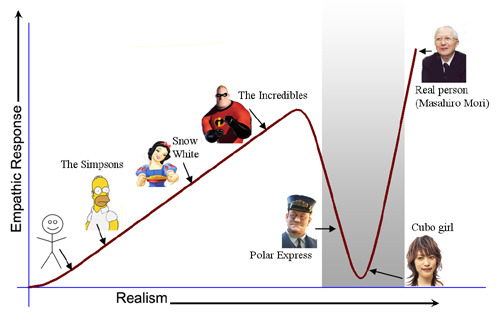
This is why 3D animated films opt for more exaggerated, cartoony character designs. Mr. Incredible does not look like a real person. Homer Simpson is not designed to look as though he exists in the real world. Our brains have a much easier time registering these designs because they are not designed to imitate reality and fool us.
A Very Brief History
In recent years, technology and techniques have evolved within the VFX industry to the point where convincing photorealistic characters are quite possible. This has been the goal of many artists since the introduction of CGI, meaning there is a great deal of research and development behind it.
While Disney is known today, for better or worse, for their recent advancements in 3D human animation, this is something that has been attempted many times over the past twenty or so years, with varying degrees of success.
Even at the time, this movie was criticized for its creepy, imperfect character models who fell deep into the uncanny valley. That being said, this film was still an immense technical achievement unlike anything that had come before, and paved the way for the truly groundbreaking effects of Peter Jackson's The Lord of the Rings: The Two Towers, released the following year in 2002.
One of the earliest experiments in 3D human animation was the 2001 Japanese-American film, Final Fantasy: The Spirits Within, directed by Hironobu Sakaguchi. This was the first fully motion-captured mainstream film, as well as the first film to utilize "photorealistic" human characters.
The Beginning of De-Aging
The Two Towers introduced audiences to Gollum, a fully computer-animated character who is still praised today for his realism. This film took the technology introduced in Final Fantasy far beyond its limits, taking Andy Serkis's motion-captured performance and taking the time to ensure his character was composited as seamlessly as possible into the live action world of the film.
A wide variety of films followed, all trying to perfect the art of CGI human beings. While some of these projects were well-executed and have aged quite well, such as (some of) the Matrix sequels. Most, however, failed to properly bridge the uncanny valley, notoriously films such as The Polar Express and The Scorpion King.
In 2006, Bryan Singer's X-Men: The Last Stand, introduced a new frontier to this evolving art: Digital de-aging. In this film, a flashback sequence shows off actors Patrick Stewart and Ian McKellen, both digitally altered to resemble younger versions of themselves.
Today, of course, the charge in the effort to perfect 3D human animation is led by none other than Disney. Specifically, Marvel Studios.
The Reign of Disney
While a bit jarring by today's standards, this was extremely new and impressive technology for 2006. It was also a technique that would once again be taken on by a number of other filmmakers in subsequent films such as The Curious Case of Benjamin Button (2008) and Tron: Legacy (2010).
Tron was Disney's first real foray into the world of digital de-aging technology. While once again, the de-aged Kurt Russell featured in the film is quite unsettling to look at, it paved the way for 2015's Ant-Man. This film opens with a flashback in which actors Michael Douglas and Martin Donovan have been de-aged approximately twenty-five years.
2016 would also see an unprecedented use of this evolving technology upon the release of Gareth Edwards' Rogue One: A Star Wars Story.
Using a miraculously found, highly detailed lifecast of the actors face from the 1984 film Top Secret, the artists at ILM were able to produce an accurate 3D sculpt of the actor's face and composite it onto the motion-tracked performance of Guy Henry. (2)
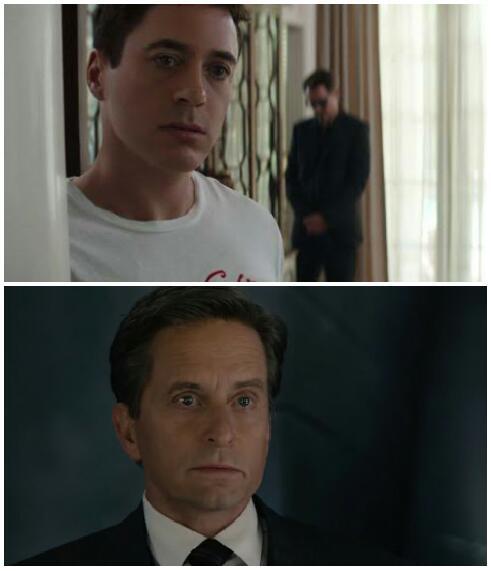
This effect was remarkably successful and the film continues to be praised for its use of the technology. This technology would again be applied the following year, in Captain America: Civil War, which features a rather convincingly de-aged Robert Downey Jr.
While imperfect, CGI Tarkin was a groundbreaking achievement in terms of technological innovation. However, it did raise a number of ethical discussions. In particular, is it ethical to use this technology to revive deceased actors? And by extension, do actors have a legal right to their physical likeness?
Star Wars Changes the Game
A major element kept secret in the marketing for the film was the prominent role of the character Grand Moff Tarkin, a major character from the original Star Wars in 1977. The immediate issue here is that the actor who originally portrayed the character, Peter Cushing, passed away in 1994.
Ethical Dilemmas
For this film, the immensely talented artists at Industrial Light and Magic were tasked not with de-aging a character, but with bringing a deceased actor back from the dead. This daunting project was achieved by casting a stand-in actor, Guy Henry, who could not only imitate Cushing's voice, but also looked a bit like him.
While Lucasfilm did receive permission from Peter Cushing's estate to use his likeness, this is something they theoretically did not have to do. Legally, it can be quite tricky to protect one's physical likeness. That being said, because they were granted permission by the estate, the studio was not heavily criticized. However, it certainly opened up an interesting ethical discussion. (3)
Again, it begs the question: is this the beginning of a trend? Disney is far from the only studio to attempt something like this. Usually when a deceased actor is revived for a role through special effects, it's for a specific reason. For example, Brandon Lee and Oliver Reed both passed during production of The Crow and Gladiator, respectively. Special effects were used to finish a project they were already heavily involved in. A character like Tarkin is different. (5)
Soon after Rogue One was released, Carrie Fisher tragically passed away before she could film her scenes as Princess Leia Organa in the ninth installment of the main Star Wars saga. Disney released a statement soon after claiming they would not use CGI to recreate her likeness for Episode IX.
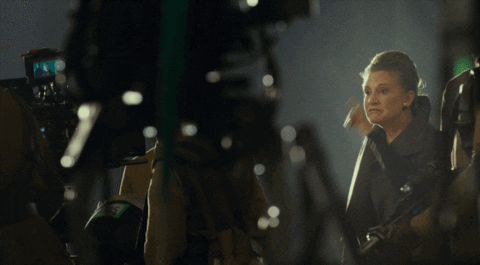
As it came to pass, the film ended up utilizing unused footage of Fisher from 2015's The Force Awakens. Writers JJ Abrams and Chris Terrio attempted to write scenes around her pre-existing dialogue to try and fit her into the overarching narrative. Whether or not this worked in the film's favor is besides the point. From a technical standpoint, it's undoubtedly impressive and a testament to how far VFX has come. (4)

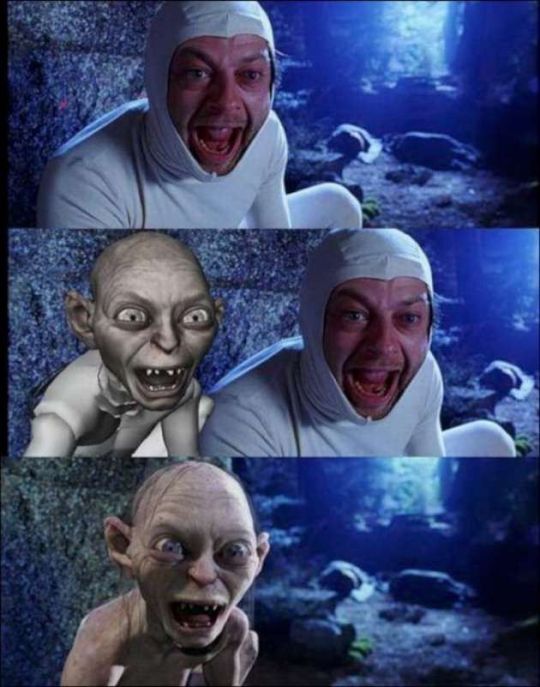
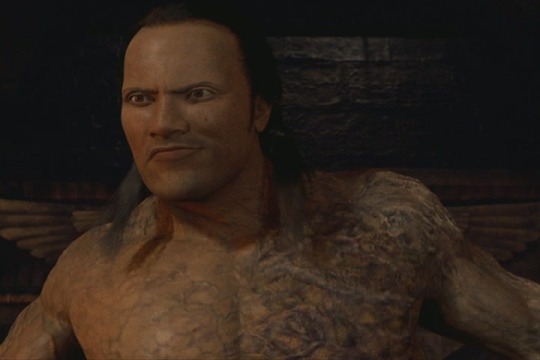

One again, however, many questioned the implications of such a practice. Like Peter Cushing's return as Tarkin, Fisher's role in The Rise of Skywalker did not face much scrutiny due to the fact that once again, the production was given the family's blessing to use her likeness in this way. Her daughter, Billie Lourd, actually plays a significant role in the film and shares scenes with her mother's character.
While exciting for hardcore Star Wars fans like myself to see, Tarkin was a character that could have been absent from Rogue One, or at least kept more to the sidelines. However, Edwards chose to make the character a prominent player for the duration of the film, showing him off in great detail quite often. They have essentially used special effects to synthesize an entirely new performance from an actor who has been dead for more than twenty years.

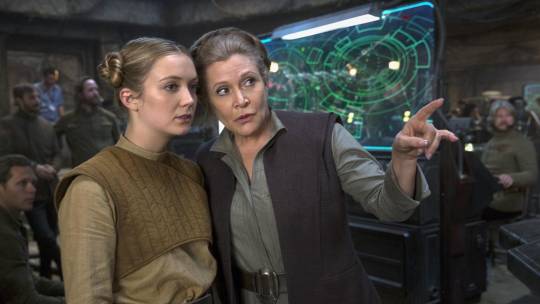
So again, could this be the start of a trend in cinema? Will we see the return of great actors who are no longer with us? Is that a bad thing? Who gets credited and paid? This is entirely new territory that comes with our rapidly growing technological advancements in the film industry. It seems that this is a phenomenon that will continue for the time being. The question remains as to whether or not legal and ethical attitudes change as a result of this ever-evolving medium.
Notes:
Bill Desowitz. "Advanced De-Aging VFX Are Crucial to The Irishman, Gemini Man, and Captain Marvel," Indiewire, October 1, 2019, accessed April 26, 2020.
(2)Bill Desowitz. "Rogue One: How ILM Created CGI Grand Moff Tarkin and Princess Leia," Indiewire, January 9, 2017, accessed May 2, 2020.
Brian Welk. "How Samuel L Jackson’s De-Aging on ‘Captain Marvel’ Cut Shooting Time in Half," The Wrap, March 18, 2019, accessed April 26, 2020.
Carolyn Giardina. "Will Smith, Robert DeNiro and the Rise of the All-Digital Actor," The Hollywood Reporter, August 10, 2019, accessed April 20, 2020.
David Ehrlich. "James Dean Is Just the Beginning: Critics Debate the Future of CGI Acting," Indiewire, November 11, 2019, accessed April 26, 2020.
Erin Winick. "Actors are Digitally Preserving Themselves to Continue Their Careers Beyond the Grave," MIT Technology Review, October 16, 2018, accessed April 20, 2020.
Laura M. Holson. "A C.G.I. James Dean? Some in Hollywood See ‘an Awful Precedent’," New York Times, November 7, 2019, accessed April 20, 2020.
Leon Miller. "14 Actors Resurrected With Crazy CGI (And 6 That Can Never Be)," Screenrant, August 9, 2018, accessed April 26, 2020.
Luke Kemp. "In the age of deepfakes, could virtual actors put humans out of business?" The Guardian, July 8, 2019, accessed April 26, 2020.
(4)Jordan Zakarin. "It Took More CGI Than You Think to Bring Carrie Fisher Into The Rise of Skywalker," Syfy, January 7, 2020.
(3,5)Joseph Waltz. "Rogue One: the CGI resurrection of Peter Cushing is thrilling – but is it right?," The Guardian, December 16, 2016, accessed April 26, 2020.
(1)"VFX Artists React to Resurrected Actors Bad and Great CGI," YouTube video, 13:20, "Corridor Crew," June 1, 2019. https://youtu.be/2ZKPnuUFwOk
#film#filmcommunity#filmmaking#star wars#marvel#carrie fisher#peter cushing#deepfake#deaging#disney#vfxartist#cgi animation#cgi#weta workshop#weta digital#industrial light and magic
22 notes
·
View notes